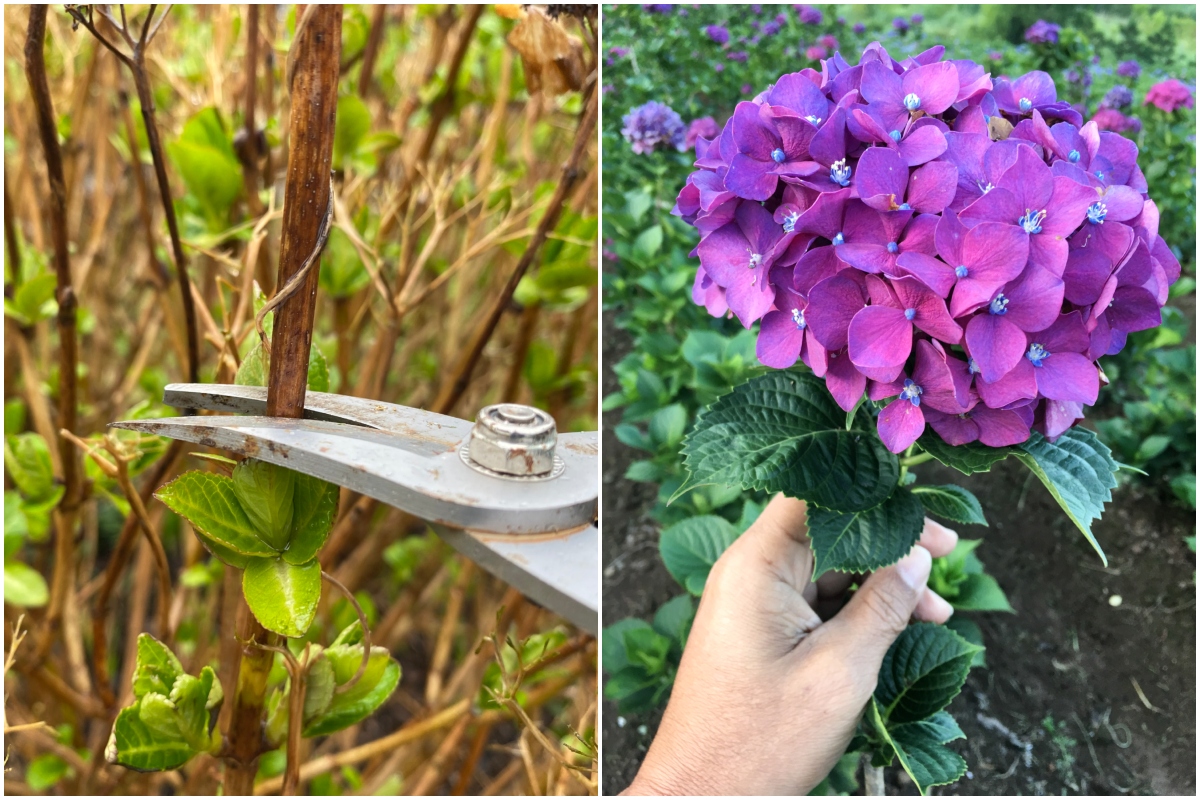
After months of impatiently glaring at the garden (as if it was its fault the weather was miserable) and having my nose stuck to the window in anticipation of spring, things are changing rapidly.
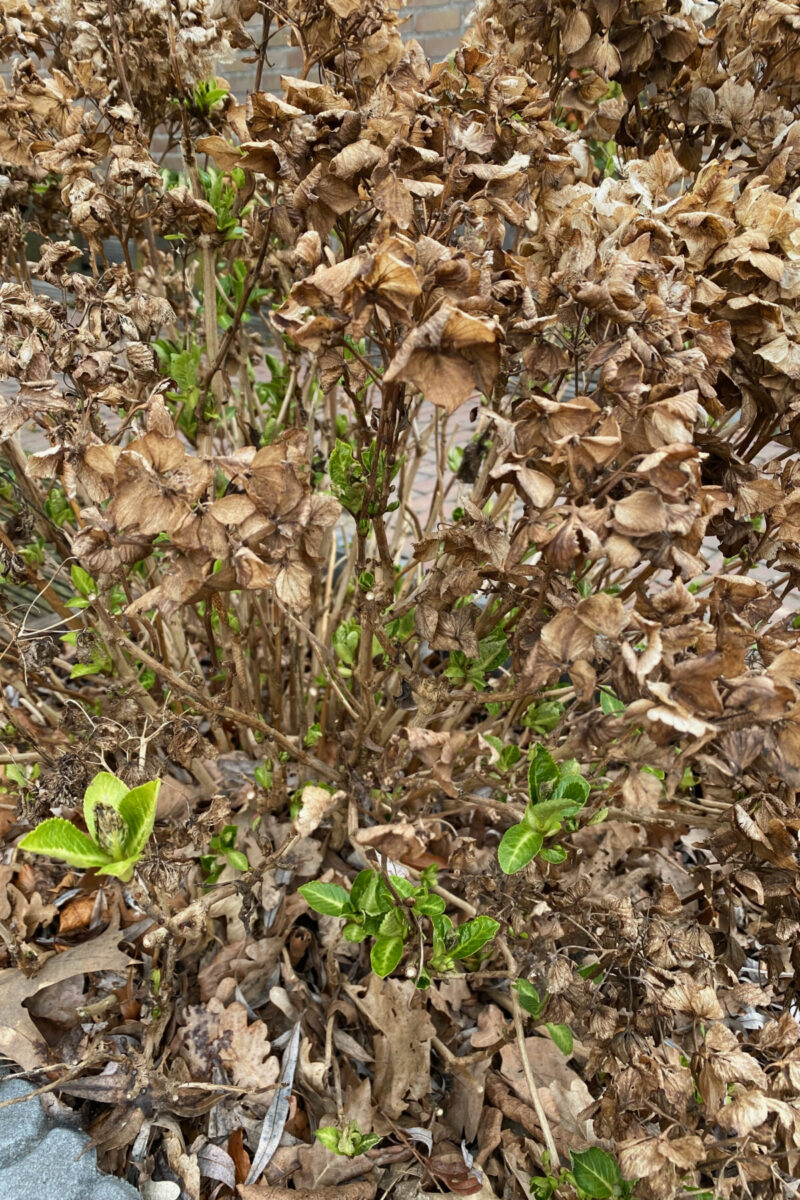
Even though the weather is still very cautious about turning into full spring, the perennials in my garden have certainly started their transformation. So between fleeting moments of enjoying my spring bulbs in bloom, it’s time to do some spring maintenance on some of my prized shrubs, my hydrangeas.
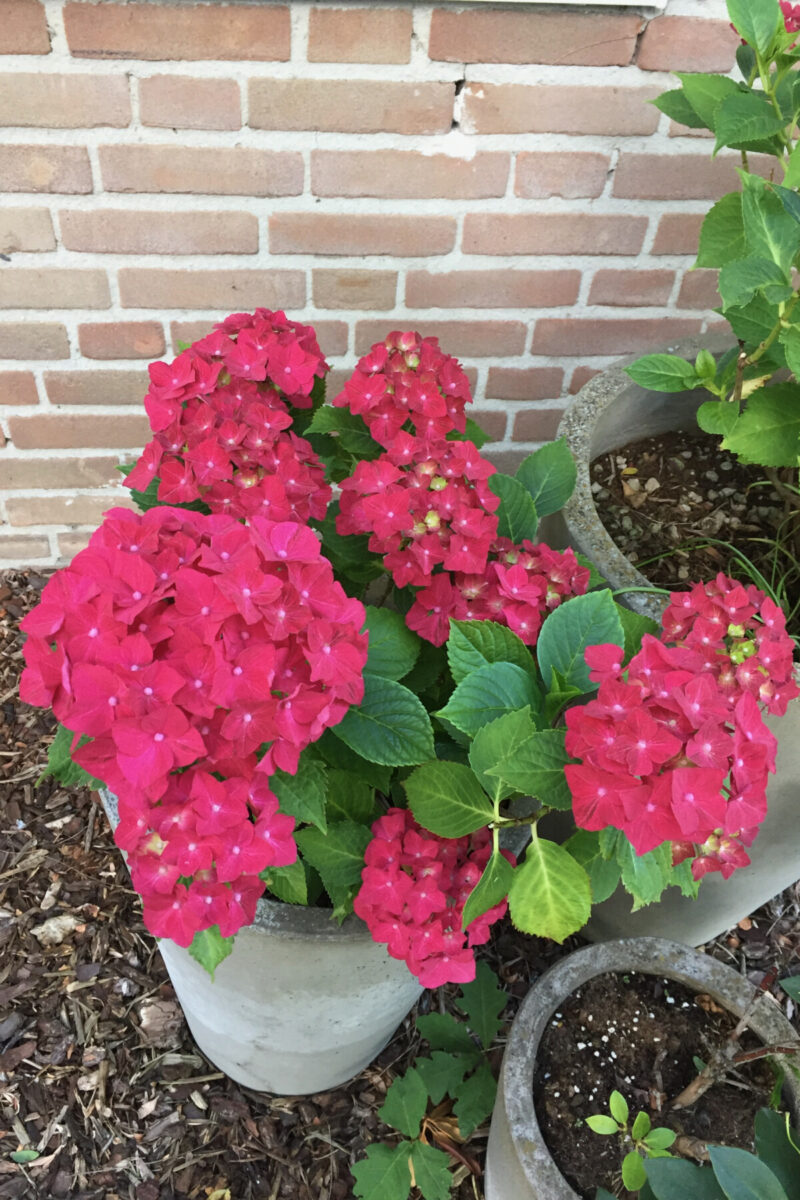
I have six hydrangeas dotted around my backyard and front garden, so I take spring jobs very seriously. In a way, I think of it as an investment of time and effort that will start paying off in mid-June. And it will hopefully keep delighting me for years to come.
If you’re also looking to take a break from seed starting and spend an hour or two in the timid spring sun, here are some spring jobs you can do for your hydrangeas.
1. Deadhead! or prune your hydrangea
Notice that exclamation mark? That’s not me turning into the Queen of Hearts from Alice in Wonderland. That’s me emphasizing that when I advise you to prune your hydrangeas, I don’t necessarily mean hard pruning. There will be very little cutting down to ground level in spring.
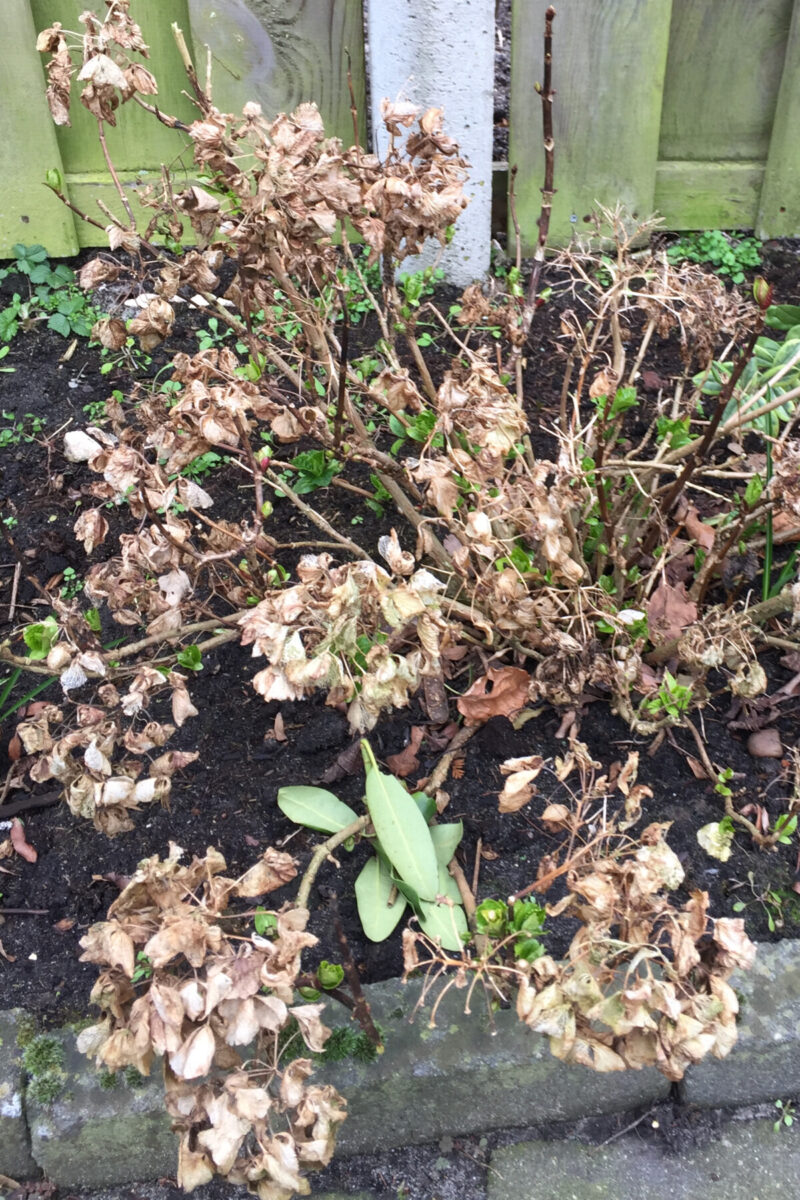
And for most hydrangea shrubs, pruning will mostly mean deadheading last year’s flowers (now very dry and very much dead) and removing old and unproductive wood.
And just to make sure that you’re not pruning the wrong hydrangea in spring, here’s a quick recap of the most popular types of hydrangea and the pruning regimen they need starting in mid-March.
Hydrangeas that just need a light pruning in spring
Hydrangea macrophylla (French hydrangea or big leaf hydrangea)
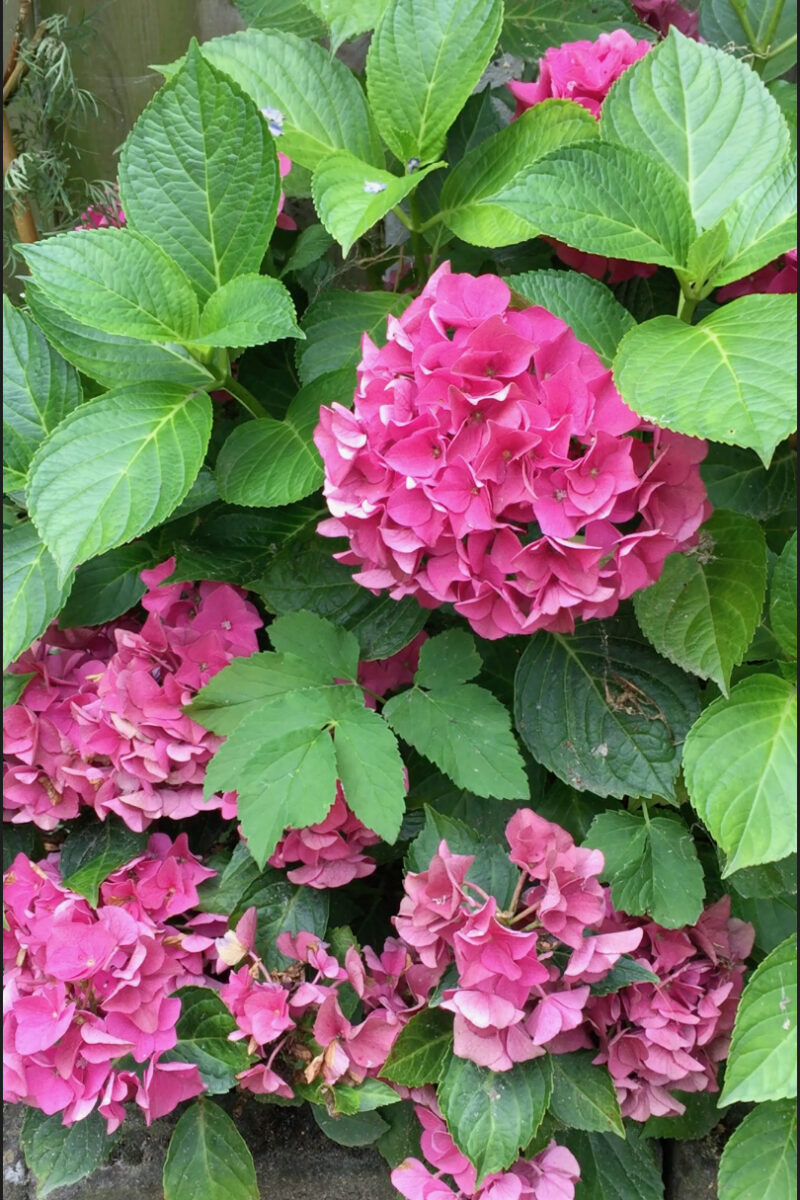
I’m starting with this one because it’s arguably one of the most popular types of hydrangea in circulation nowadays. Its blue, purple or pink pom-pom flowerheads bring an old-fashioned charm to any garden. I’m currently growing some French hydrangea in pots, as well as on the sunny side and the partly shady side of the garden.
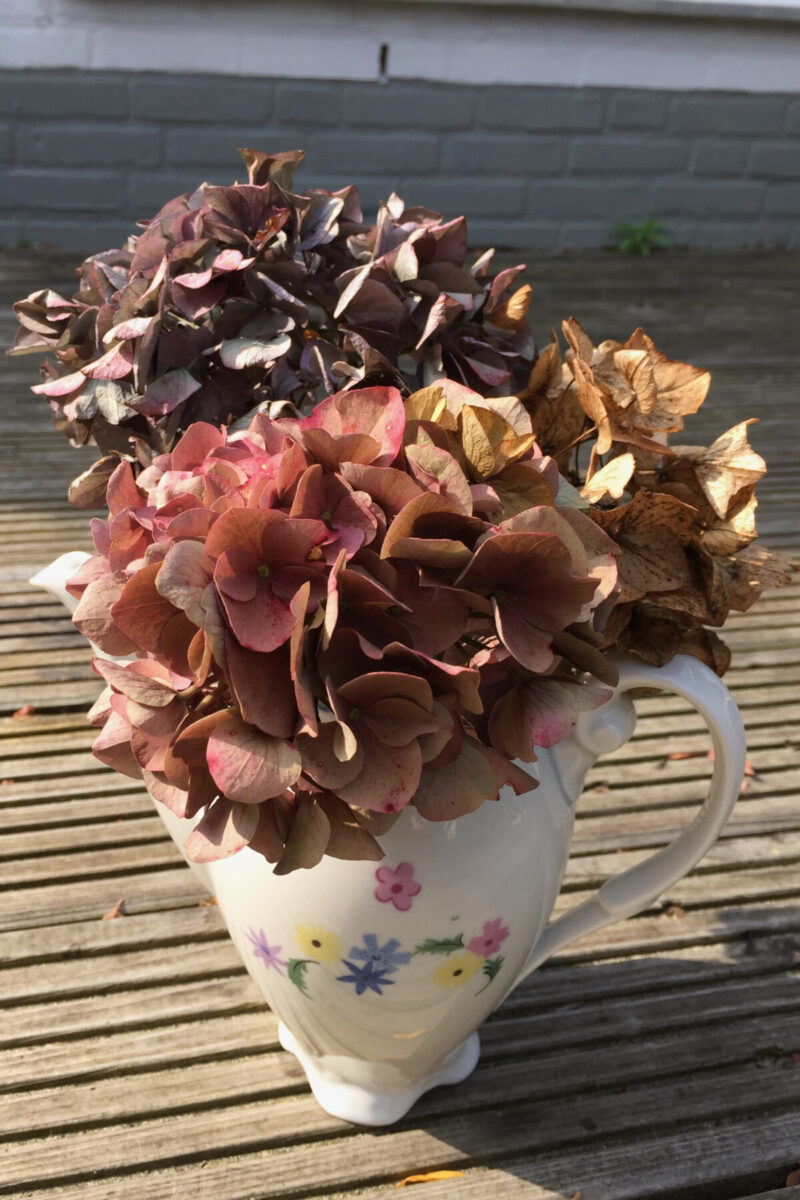
In the fall, when the blooms are on their way out, I like to collect some and use them in dry flower arrangements.
I leave most blooms on their stems to serve as protection in the cold winter months. But when winter is over and March rolls around, it’s time to remove these old flowerheads.
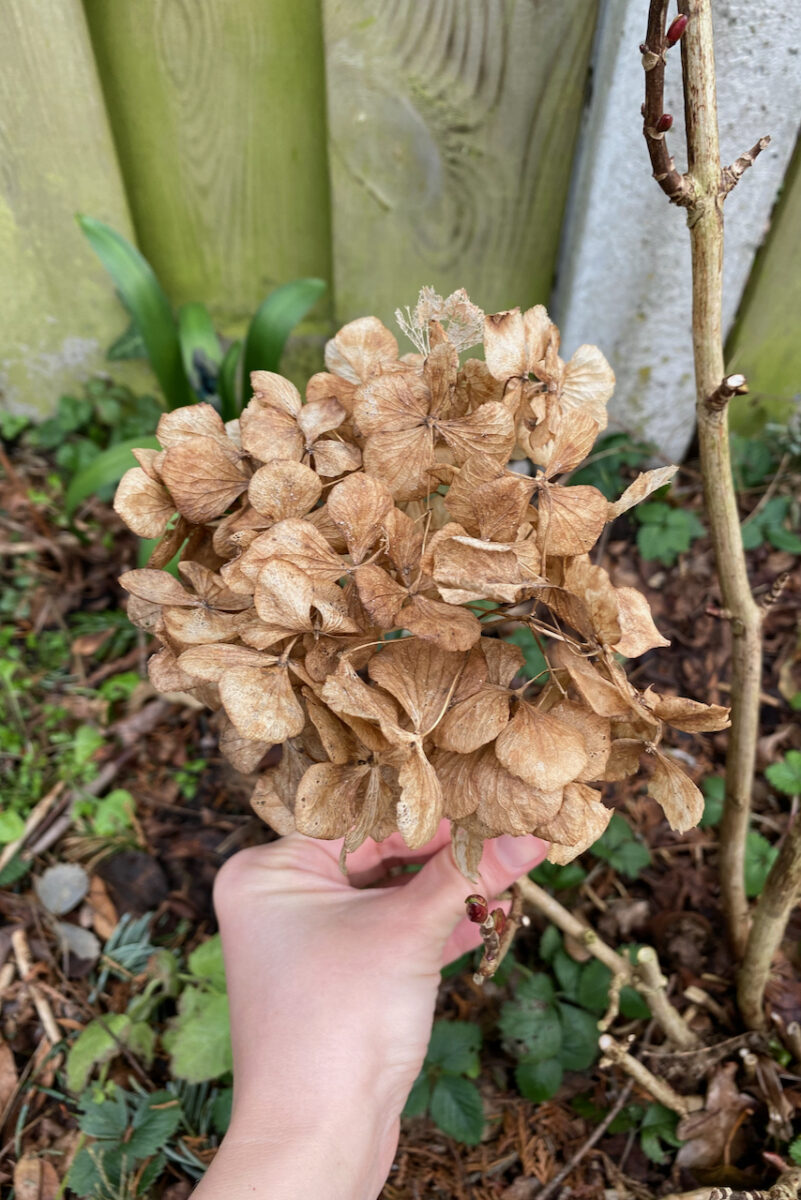
Hydrangea macrophylla blooms on last year’s growth, so you shouldn’t prune it hard in spring, otherwise you risk removing all this year’s flowers. (Come to think of it, you should never prune it hard). Cut right above the first bud (counting from the top) to remove the dead flowers.
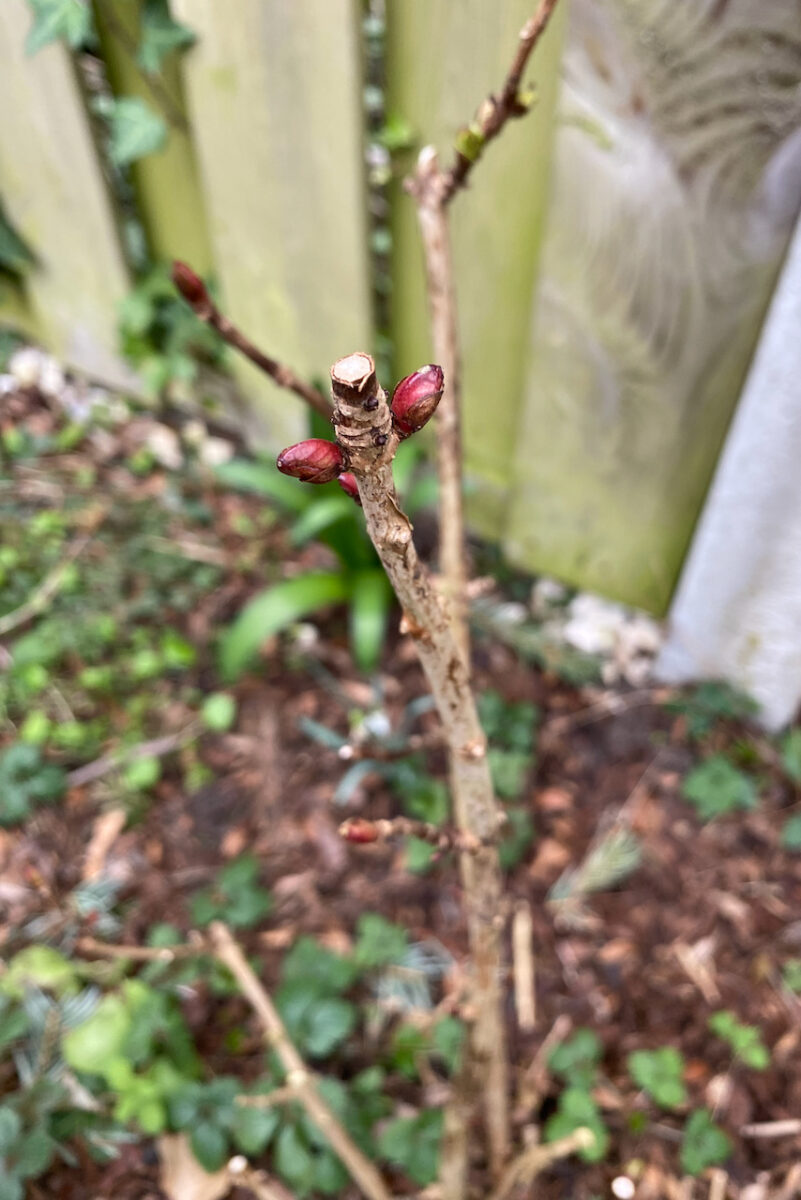
Occasionally, especially if you have an older French hydrangea shrub, you may find that some of the stems have dried out. You can tell just by looking at them. They look lighter and paler in color than fresh growth. They will also feel hollow to the touch and will have snapped during winter.
But the dead giveaway is a distinct lack of buds on these old stems. So it’s very unlikely that they will produce any flowers or leaves this year. You can remove these dry stems by cutting them down to ground level.
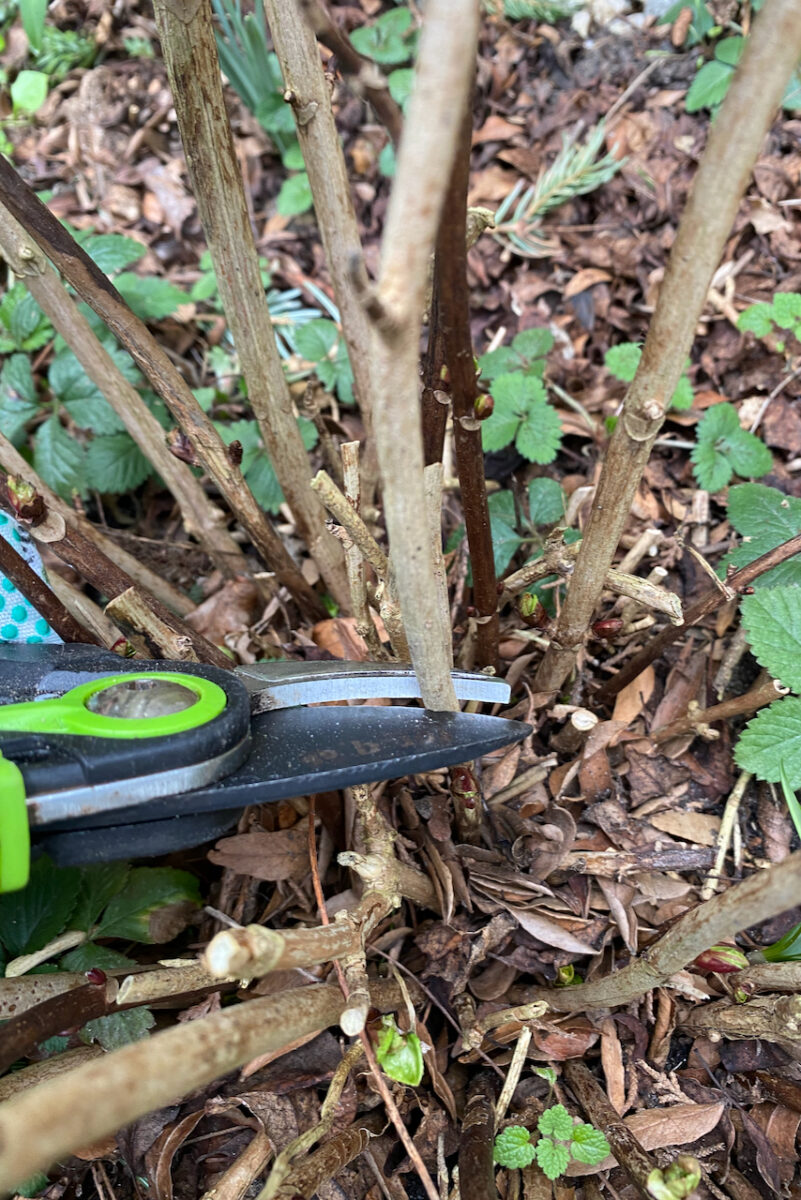
Hydrangea aspera (Rough-leaf hydrangea)
Hydrangea aspera is another looker that comes in deep shades of pink, purple or blue. But its flowerheads are flat and resemble more a lacecap than a mop head. And the foliage is more velvety and rough-textured compared to that of French hydrangeas.
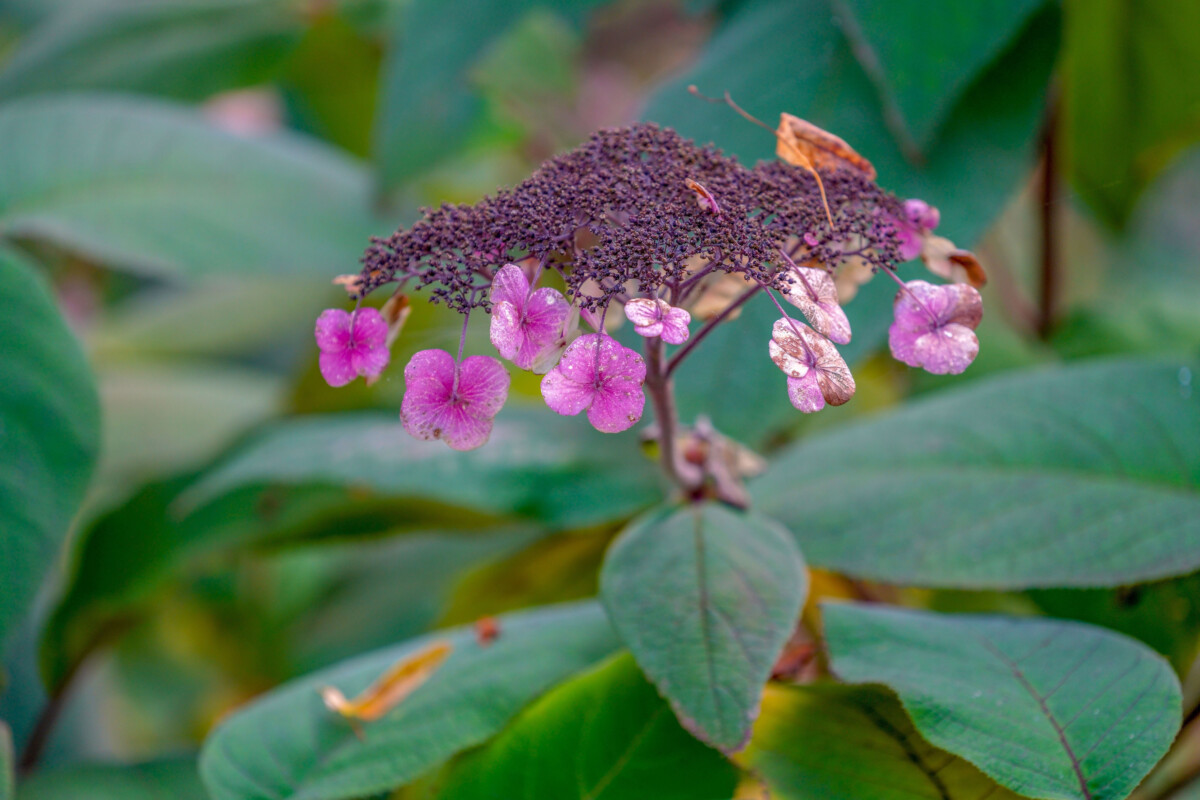
Just like H. macrophylla, Hydrangea aspera also flowers on last year’s growth. So you should trim old flowerheads back to the first pair of buds underneath. This type of hydrangea might grow a bit taller and fuller in foliage, so if needed, you can cut back one or two old stems.
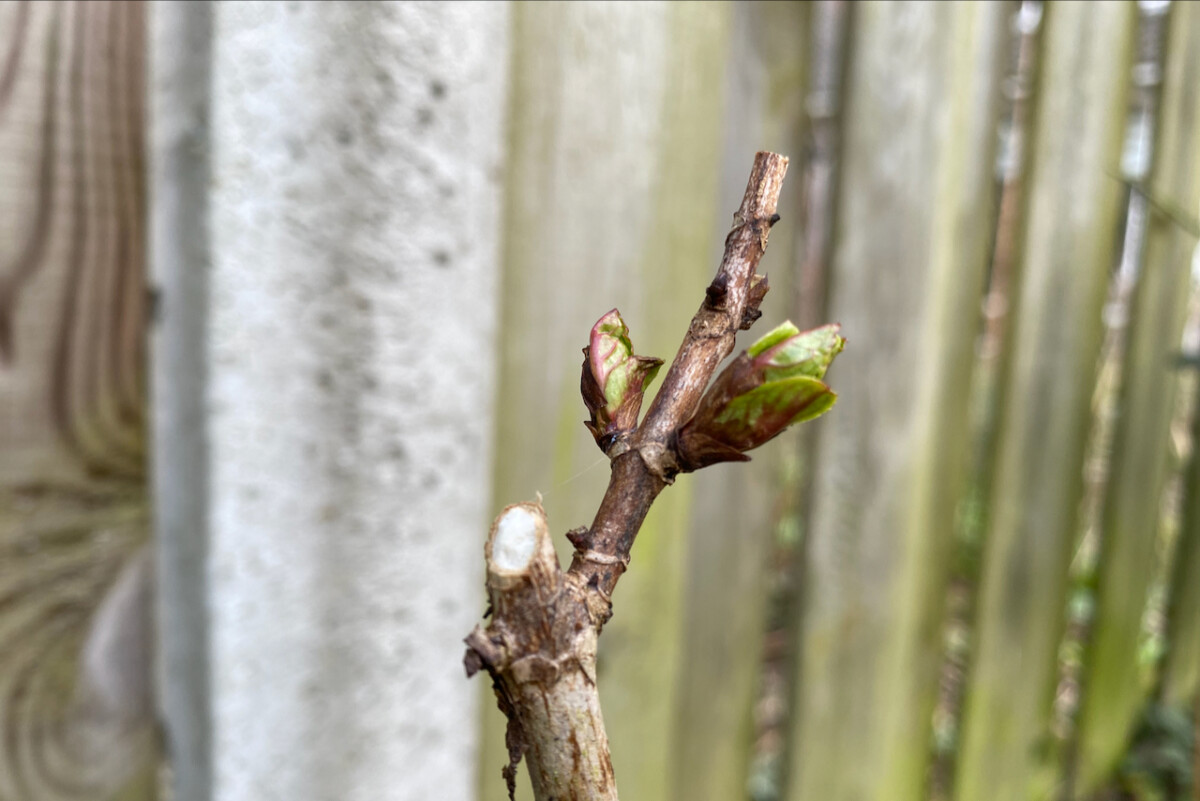
Prune these old stems back down to ground level if they have become unproductive. Don’t be tempted to prune down more than a couple of canes a year though. This will ensure that you have plenty of blooms while also slowly regenerating the plant over the span of a few years.
Hydrangea serrata (Mountain hydrangea)
Mountain hydrangea, while not yet as popular as the H. macrophylla in the United States, should be your go-to if you have a partly-shaded garden. Mountain hydrangeas also do much better than classic French hydrangeas in gardening zones that get long, cold winters and high winds. Another reason for their hardiness is the fact that they open up later in spring. So they avoid late-frost damage that often affects the impatient French hydrangeas.
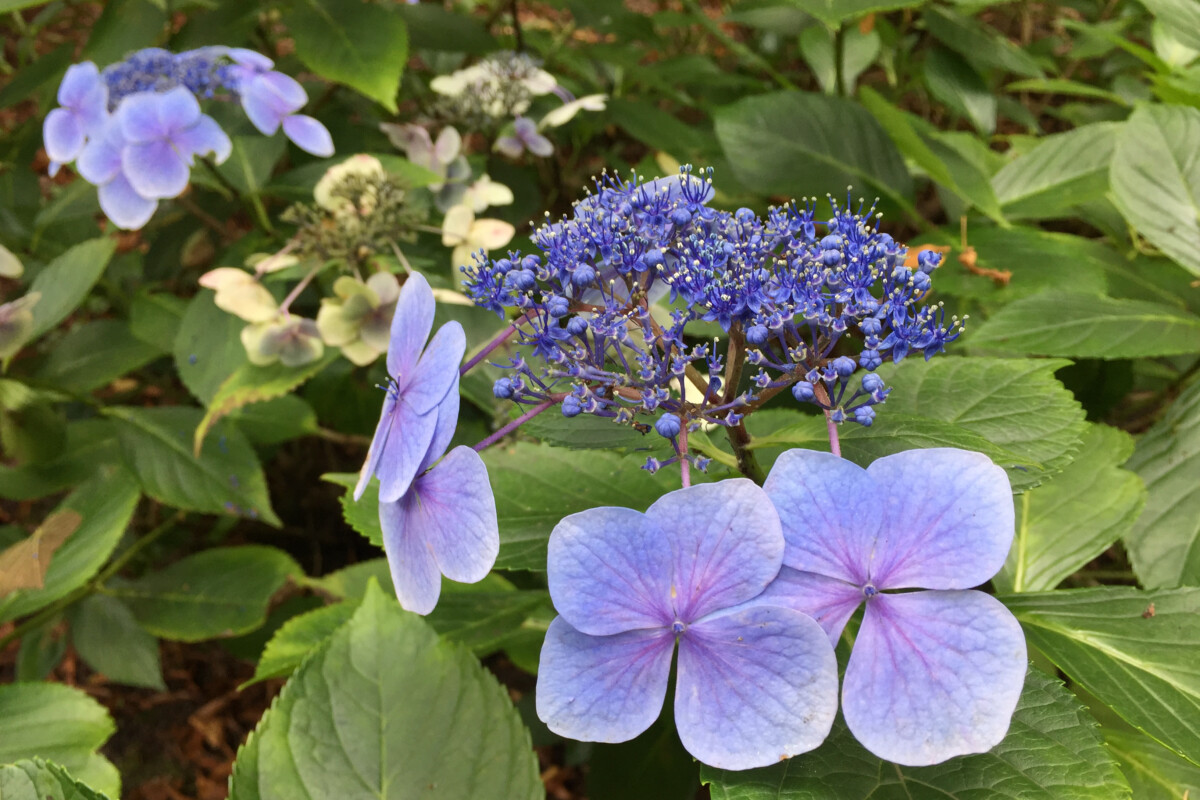
The lacecap flowers of Hydrangea serrata resemble that of Hydrangea aspera, but the large, glossy foliage is more similar to Hydrangea macrophylla. And just like H. macrophylla, the serrata might flower blue, purple or pink, depending on the acidity of the soil. (We’ll come back to this later.)
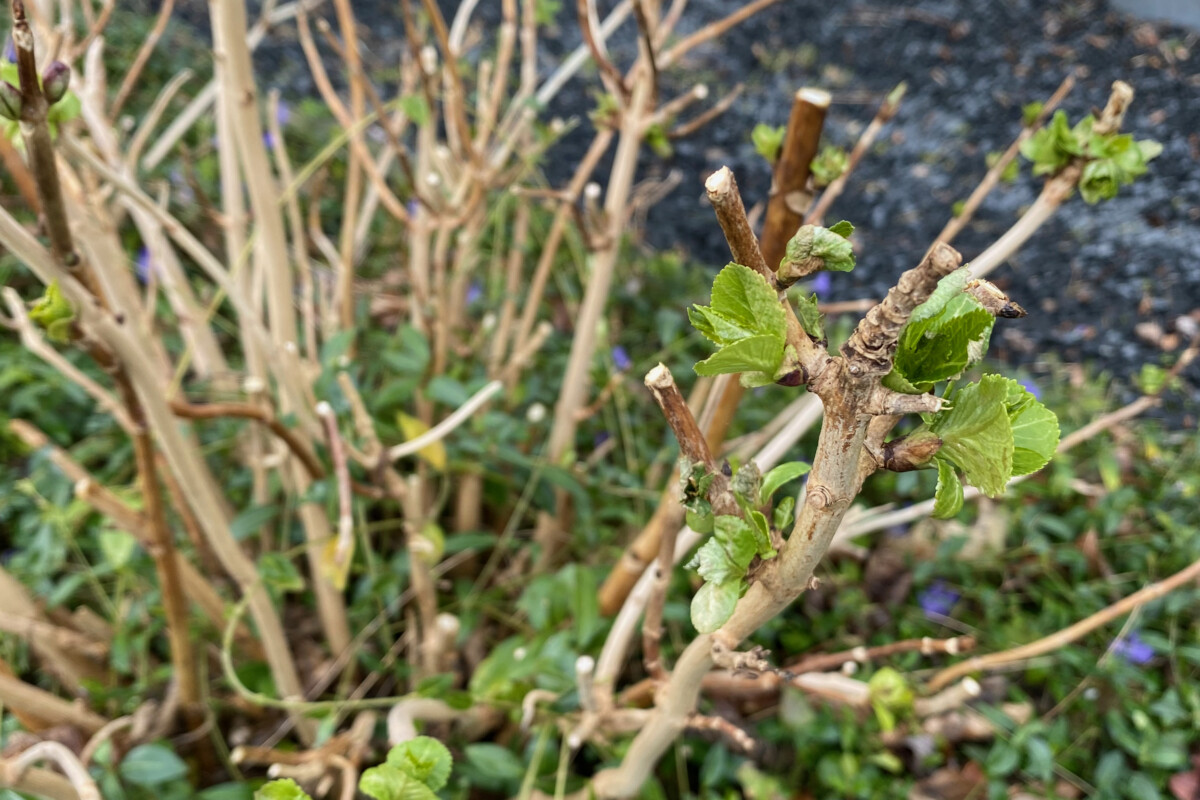
This type of hydrangea also flowers on old wood, so the same pruning advice applies. Remove the dry flowerheads down to the first pair of buds right below it. You can remove the old crackled stems down to the ground, but no more than a couple every year.
Hydrangea quercifolia (Oak leaf hydrangea)
One of the attractions of the oak leaf hydrangea is its oversized flowerheads. But they generally only bloom in shades of white.
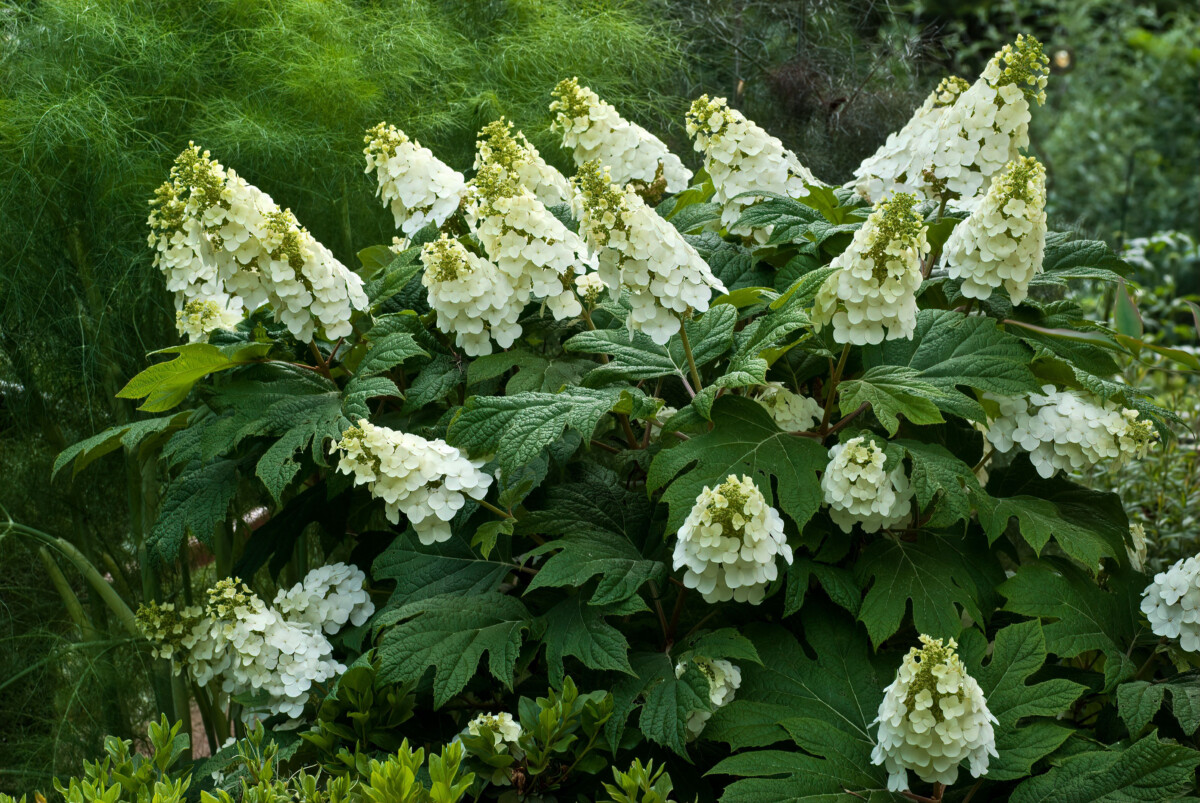
However, what Hydrangea quercifolia lacks in flower variation, it makes up for in foliage. As the fall season progresses, the large lobed leaves of these hydrangeas turn from green to mesmerizing shades of amber and purple.
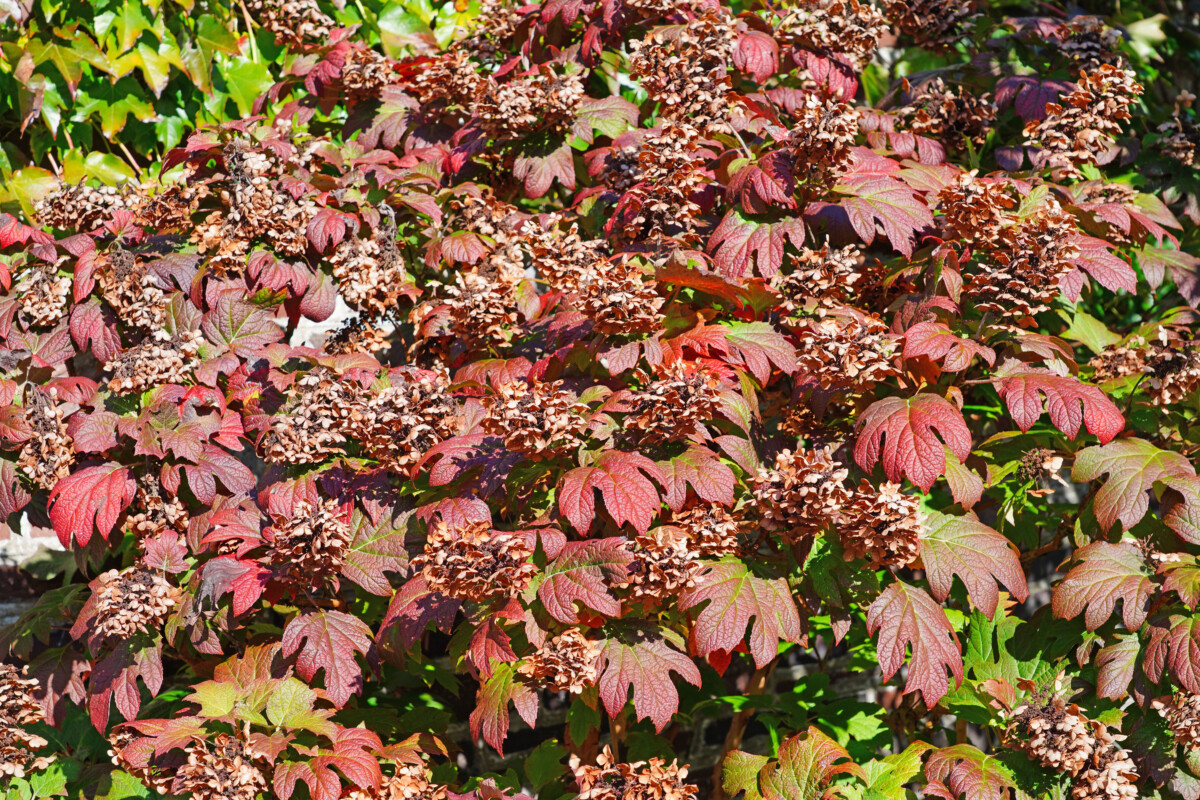
Hydrangea quercifolia is a vast shrub that can reach up to 12 feet in height (about 3.6 meters). But its impressive stature doesn’t give gardeners a license to prune it hard. This hydrangea, just like the ones above it, blooms on old wood. So the only type of pruning it needs in the spring is deadheading the old dry flowers down to the first bud.
Hydrangea petiolaris (Climbing hydrangea)
I’m growing several climbing hydrangeas, both on the front of my house – on a trellis, not on the house itself – and in my backyard. While the other types of hydrangea that I grow are mostly decorative, climbing hydrangea is both beautiful and functional.
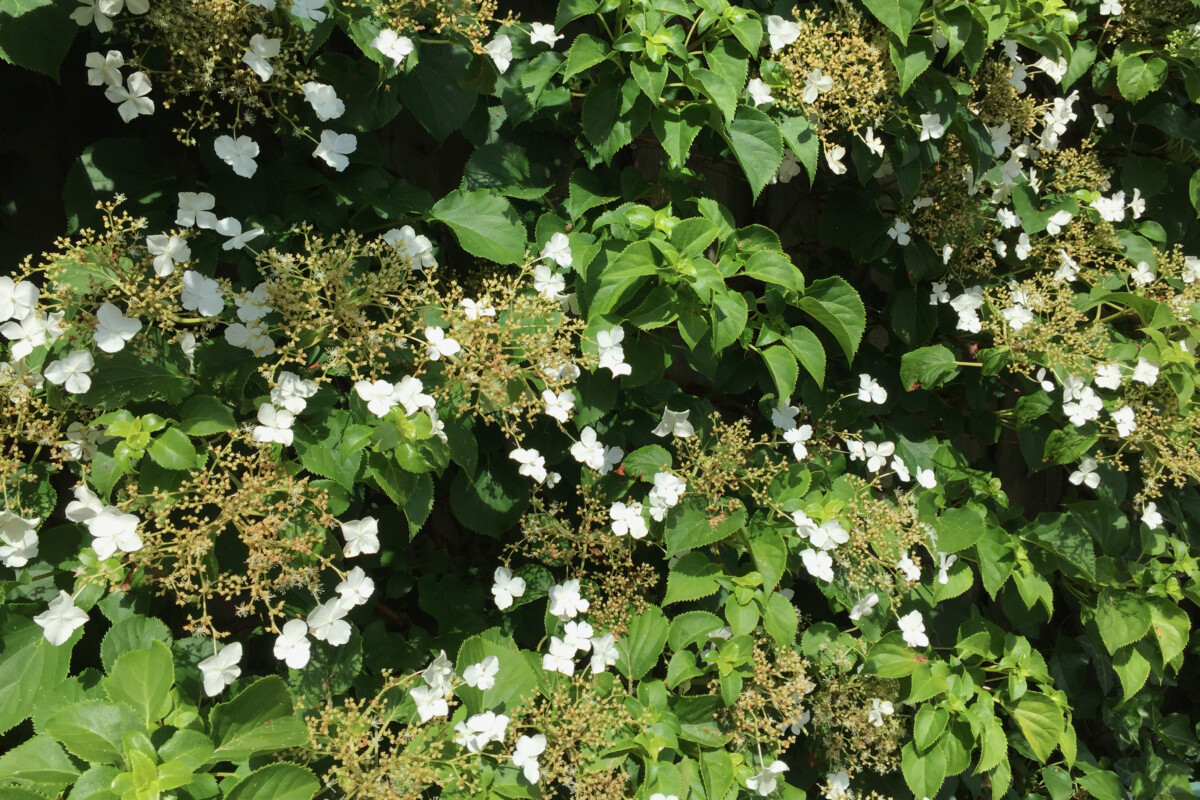
From mid-spring to late fall, when it’s fully leafed out, it creates a green wall that insulates my house from heat, humidity and noise. While visiting a botanical garden, I’ve also seen climbing hydrangeas used as a groundcover of sorts, which you can easily achieve if you train it horizontally rather than vertically.
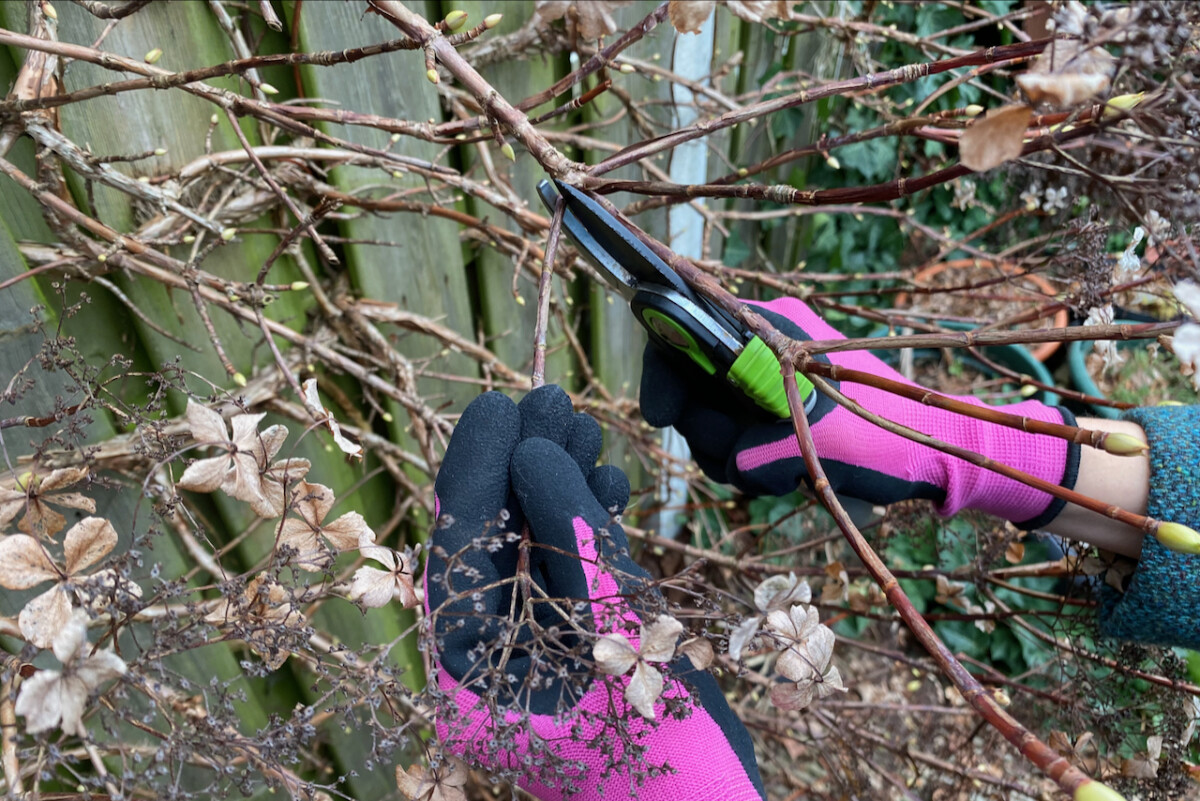
I’ve already written an article on how to deadhead and tidy up your climbing hydrangea in spring. In a nutshell, the one thing to keep in mind is that Hydrangea petiolaris grows on old wood and doesn’t need much pruning. So in spring you’re just removing the dry flowerheads and any branches that may have died over the winter months.
Hydrangeas that you can prune harder in spring
If you’re an eager pruning machine, just waiting for a chance to tuck into a dormant plant once spring rolls around, here are some hydrangeas that flower on new wood (this year’s growth).
Hydrangea arborescens (Smooth hydrangea)
This is perhaps the most popular type of new wood hydrangea. Even though in its wild form it’s native to the Eastern coast of the United States (from New York State all the way down to Florida), what we’re more likely to encounter in gardens across the US and Europe are its two most popular cultivars, ‘Anabelle’ and ‘Grandiflora.’
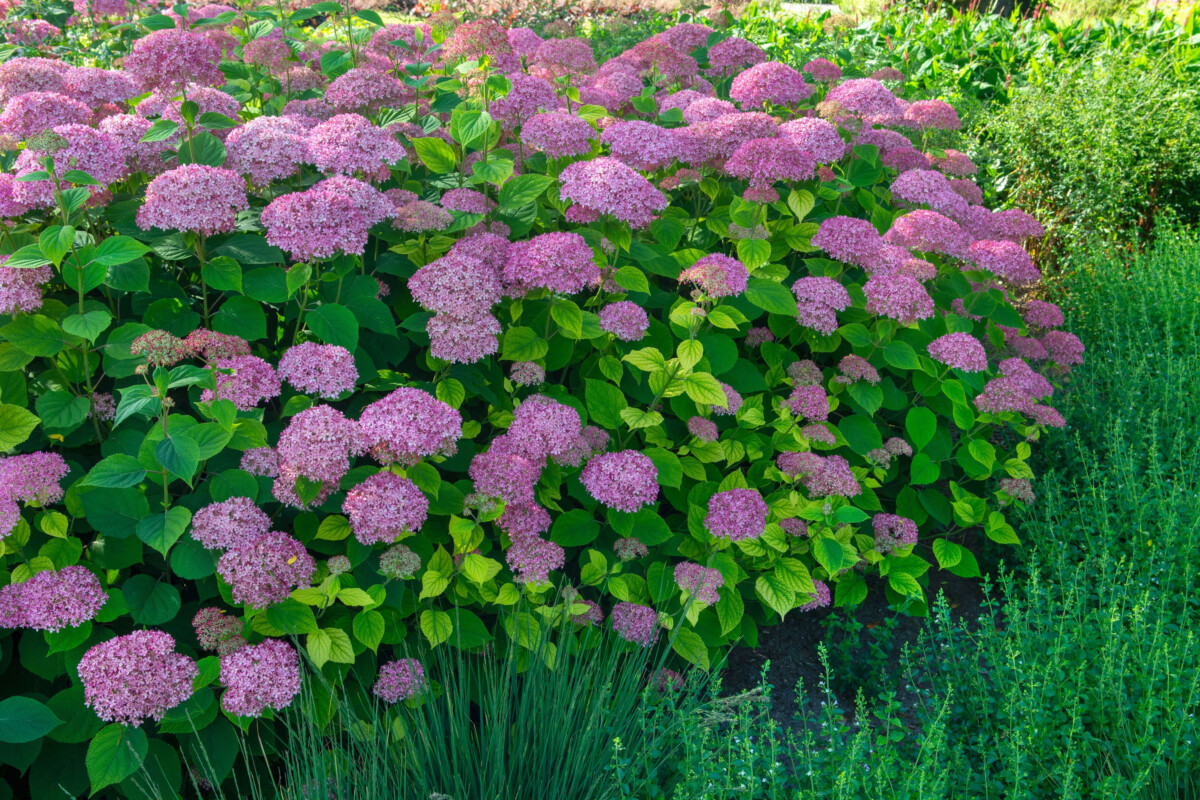
Due to its origins as an understory shrub in the wild, this is one of the best hydrangea choices for a shadier garden. It actually prefers part-shade to full sun, unlike the popular H. macrophylla.
While you can buy ‘Anabelle’ in shades of pink, you’re more likely to encounter them as white poofy flowerheads. They make me think of the sugary popcorn balls that were my “mandatory purchase” at summer fun fairs when I was a kid.
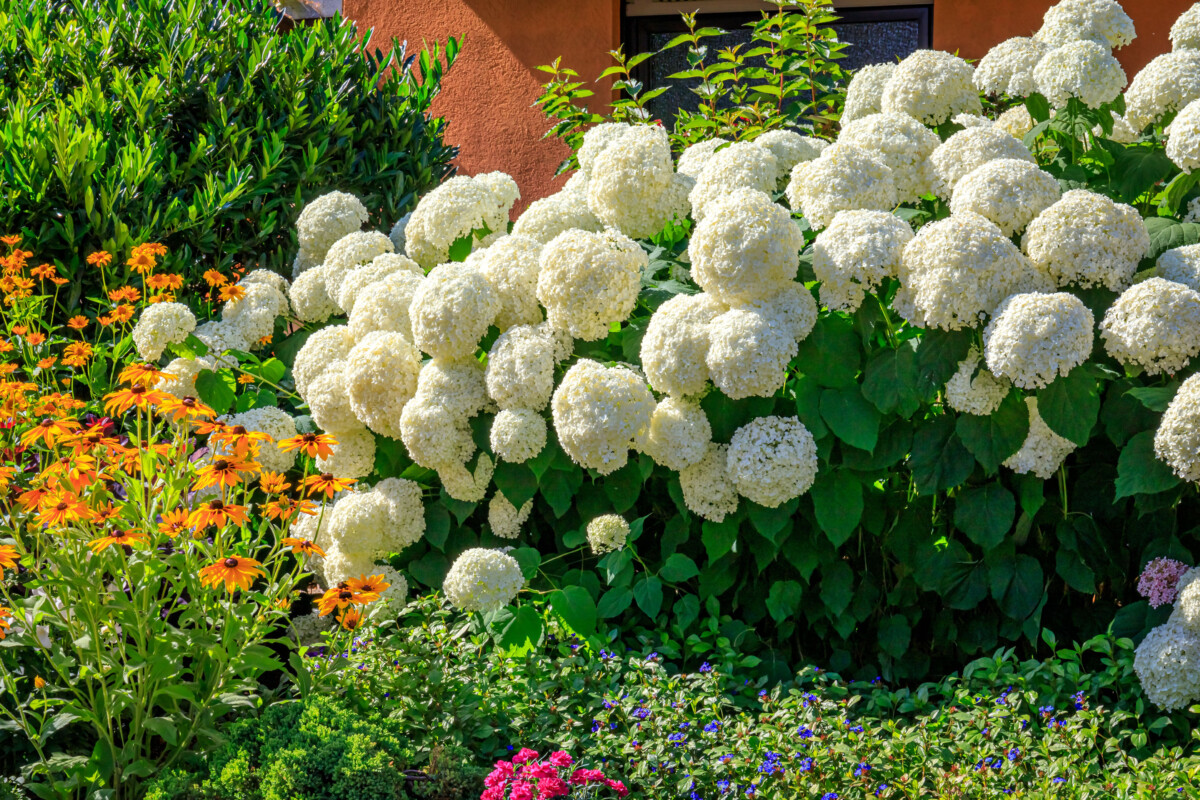
Smooth hydrangea flowers from May to July on stems that have been developing in the current year. It can grow up to five feet (about 1.5 meters) from March until May, so it needs a hard prune in spring. You can cut it down to a couple of inches off the ground around mid- to late March.
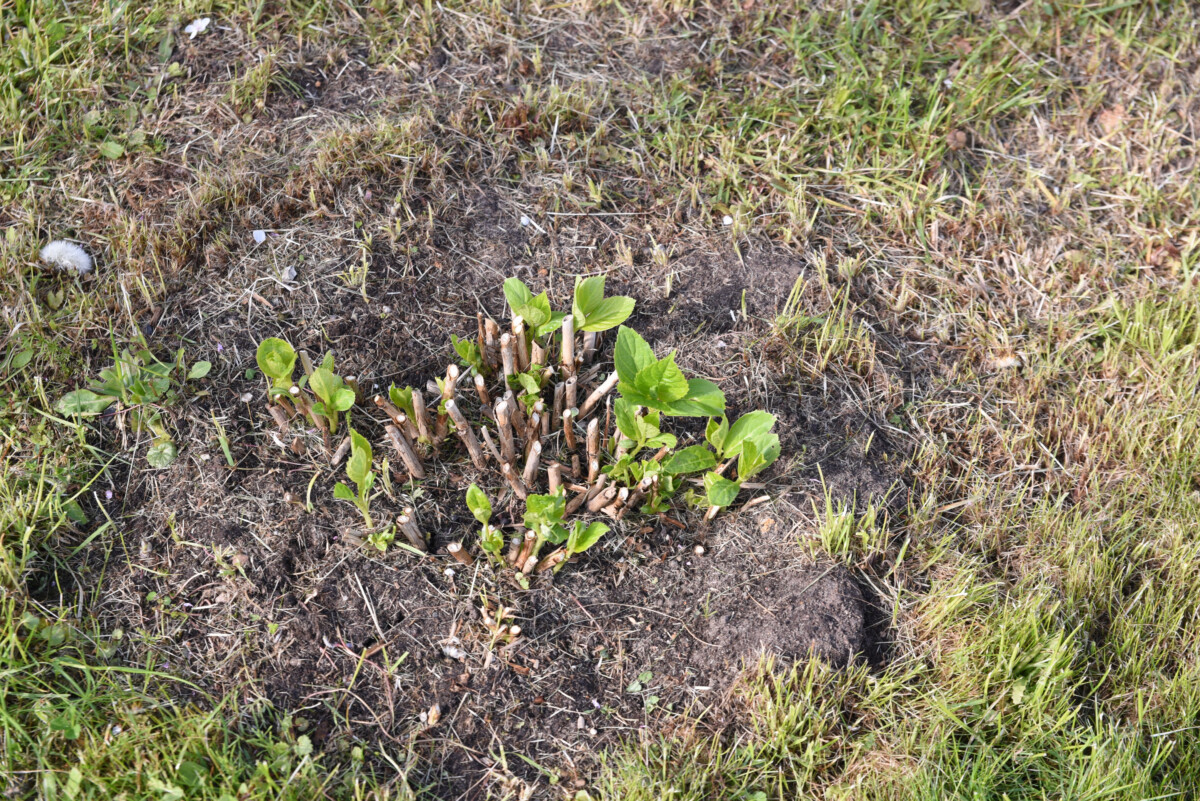
Don’t worry if you don’t see the new blooms forming just yet. It’s slow to start, but once it does, it will shoot up very quickly.
Hydrangea paniculata (Panicle hydrangea)
Hydrangea paniculata has cone-shaped flowers in pastel shades of off-white, pale pink and mellow lime. The blooms can be either tightly clustered or resemble lacecaps. The shape of the flowerheads reminds me of lilac flowers.
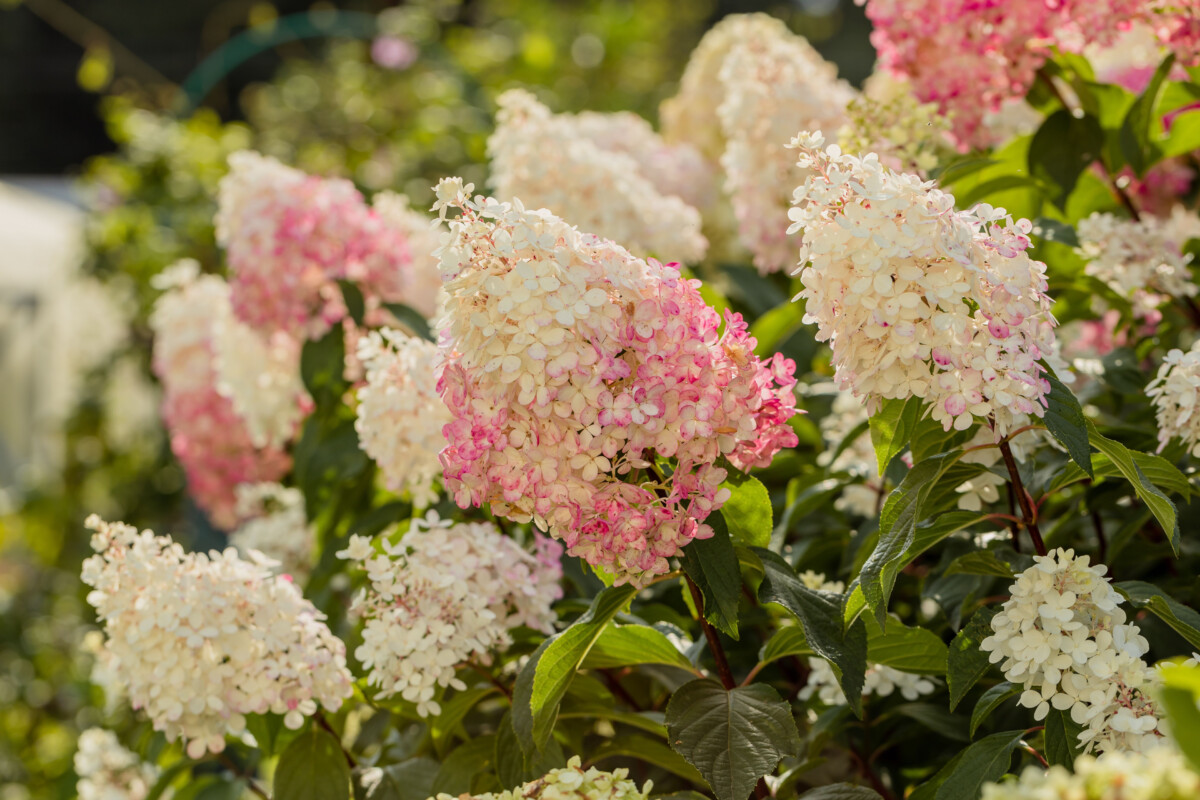
This kind of hydrangea also flowers on new wood (this year’s growth), but it’s not always a good idea to prune it down to the ground. Instead, you can prune it back to a framework of older branches, about a foot tall from the ground. This arrangement will maximize the blooms and make sure the flower doesn’t spend most of the season putting out new branches.
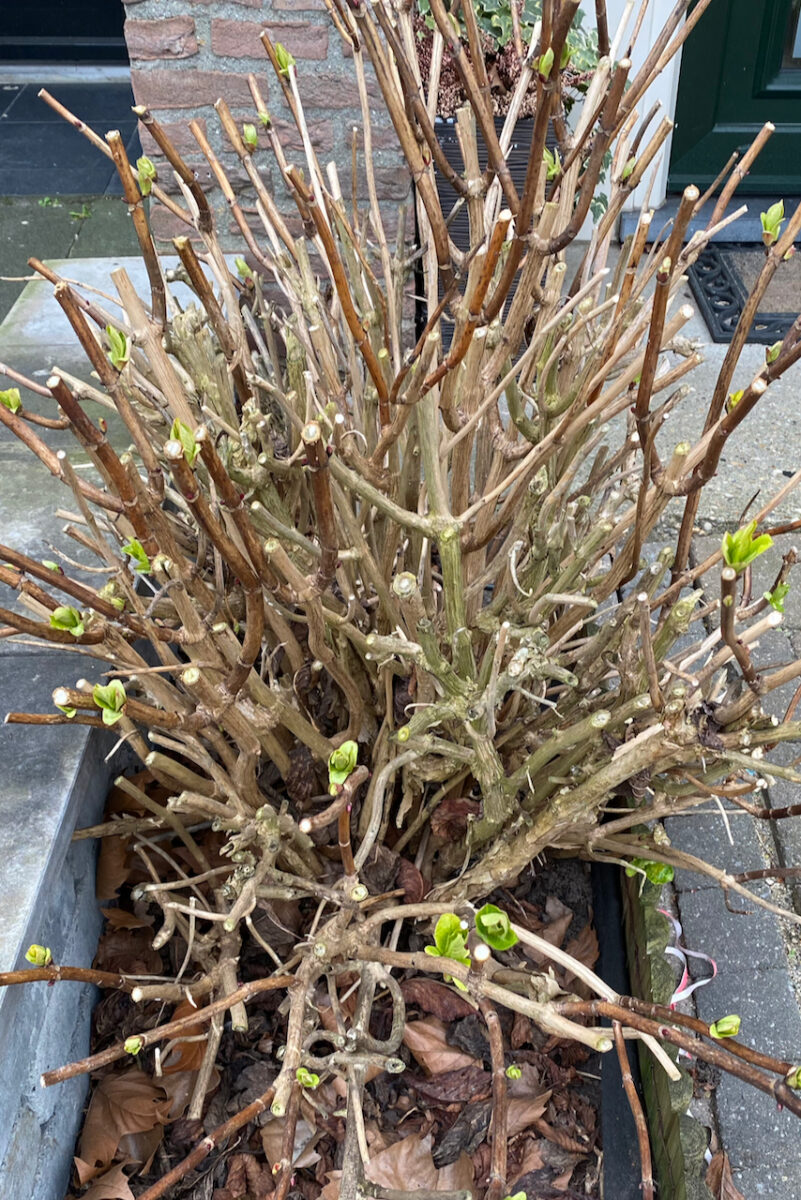
Before you prune panicle hydrangea, it’s better to wait until you see the new shoots coming out. Then you can remove about a half to a third off the top, trimming the branches right above a leaf node. Most cultivars in this group grow about three or four feet tall (a little below one meter), so trimming it down to about one to two feet should be enough. However, there are taller cultivars that you can also prune taller.
If your Hydrangea paniculata is still young, you don’t have to prune it that low. But it will eventually need pruning over time; as it blooms one new wood, if you leave it unpruned, the flowers will emerge way above eye-level in a few years’ time.
How do I know which type of hydrangea I have?
If you’re not sure what type of hydrangea you’re growing, I would advise you to take a year just to notice what your plant is doing. Don’t be tempted to take any drastic action too soon. Just notice whether your hydrangea is blooming on old wood (last year’s growth) or on new wood (this year’s growth).
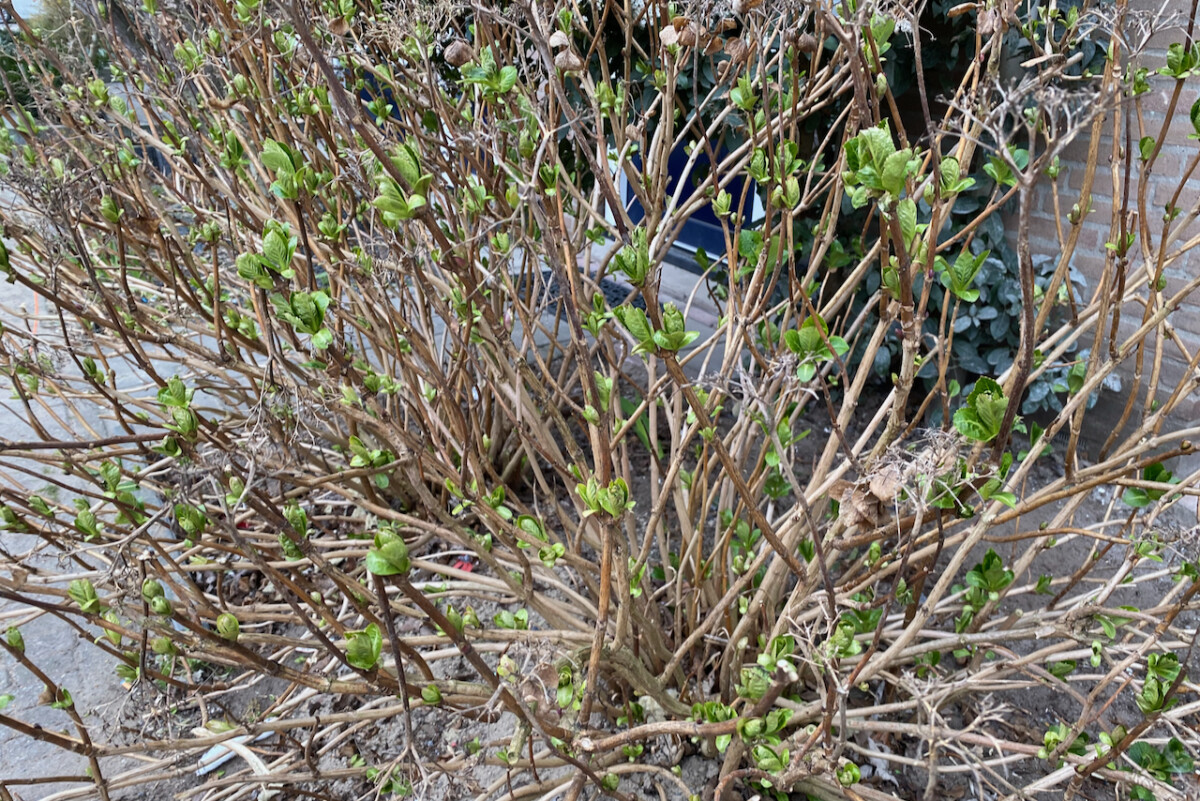
If needed, you can do a bit of deadheading. Always remove the dry flowers down to the first pair of buds underneath. If you notice that your hydrangea produces flowers on this year’s stems, you can prune it hard next spring.
Now that you have a good grasp of pruning (or rather when to skip spring pruning), let’s go back to other spring jobs for hydrangea growers.
2. Resume your watering schedule.
This is a spring job that can easily be overlooked, depending on the type of climate you live in. But it’s especially important for hydrangeas coming out of dormancy to get enough water in order to encourage leaf and flower development.
Now if you live in a climate that gets plenty of rain throughout spring, then you can skip this step. But if you’re in a drier climate, making sure your hydrangea is watered properly is essential.
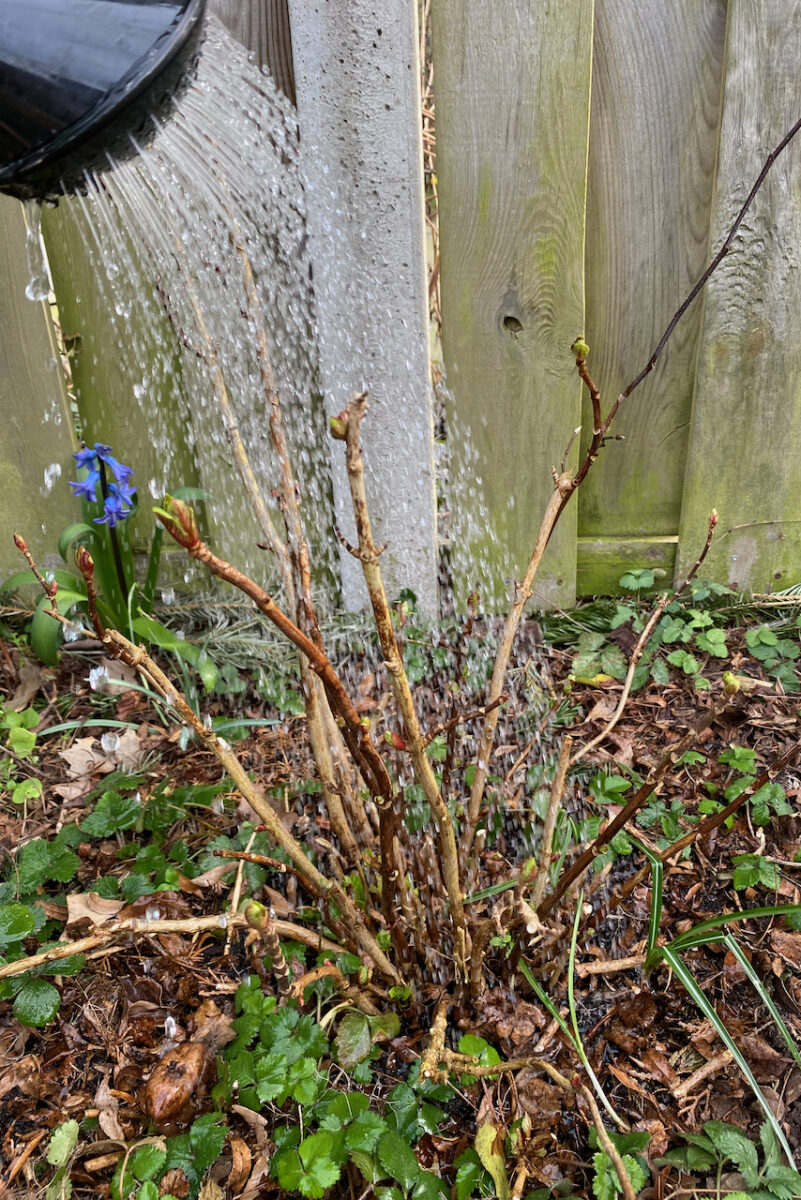
Generally, the larger the plant, the more water it will need. But also, the more sun your plant gets, the more water it will need. Hydrangea macrophylla are not particularly drought-resistant, so if that’s what you’re growing, make sure you water them during dry weeks.
Watering your hydrangeas properly becomes even more important if you’re growing them in pots. Make sure the soil in the pot is moist (but not soggy) at all times.
3. Change the color of your hydrangea blooms (optional).
Did you know that you can influence the color of some of your hydrangeas, to a certain extent? If your soil is alkaline (it has high pH), the hydrangea flowers will bloom in shades of pink. But if your soil is more acidic (low pH), the hydrangea will bloom in shades of blue. Transitioning from one to another is a process that you should start in spring. It’s worth noting that you’ll only be able to play this trick on Hydrangea macrophylla and Hydrangea serrata.
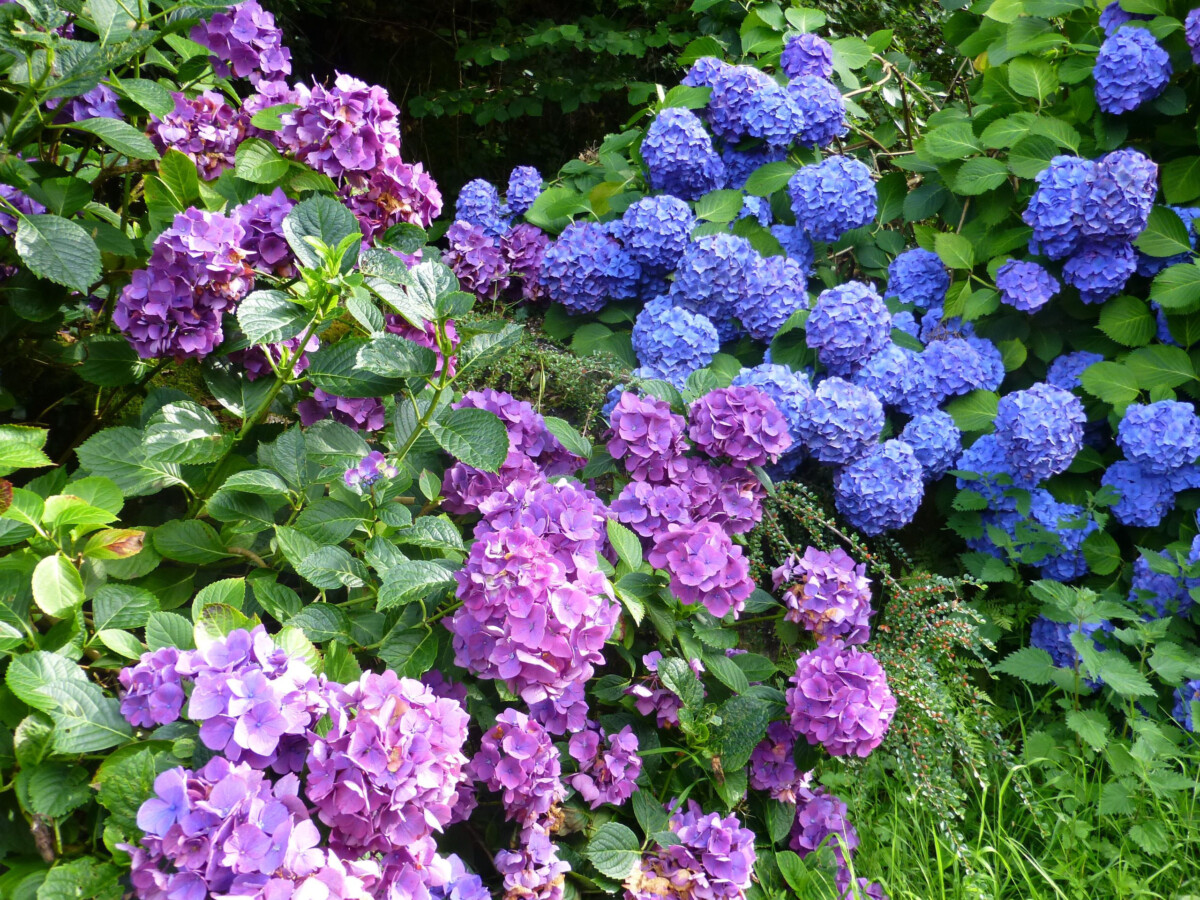
Even for these two types of hydrangea, you may not be able to get a true blue color, but you will get rich velvety purple. Here’s what you’ll need:
To go from pink to blue, you need to reduce the pH (ideally to less than 6 on the pH scale) in your soil and make it more acidic. A sprinkle of horticultural aluminum sulfate should do the trick. The aluminum can alter the pigments in the blooms, but the soil needs to be slightly acidic in order for the plant to absorb the aluminum. Always follow the instructions on the packaging when you apply any kind of product to your garden.
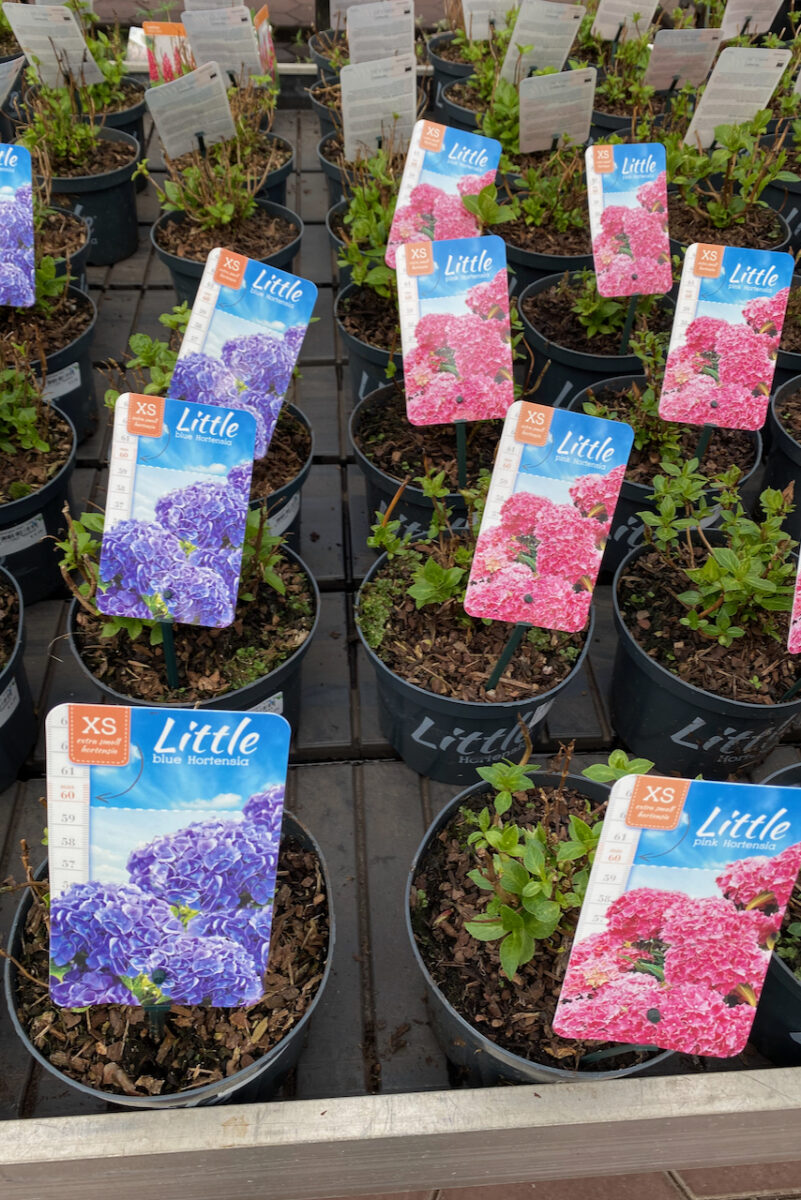
Even if you buy blue hydrangea, it might revert back to pink the following year if your soil isn’t acidic enough.
To go from blue to pink, you need to make your soil more alkaline. In this case, you can add horticultural lime to your soil. Again, follow the instructions on the bag.
Personally, I prefer to use more natural ways of making my soil more acidic, such as using coffee grounds, pine needles and leaf mold. Elizabeth wrote a great guide on eight ways to make your soil more acidic that includes a lot of natural methods.
4. Feed your hydrangeas with some fresh compost.
Now is the time to add a generous serving of mature compost all around your hydrangea. I start close to the stem and work my way out until I’ve covered the entire drip line of the shrub. Then I keep adding compost until it reaches a couple of inches in thickness.
I like to do this with all of my plants, but hydrangeas are hungry shrubs so they get an extra serving of fresh compost in the spring.
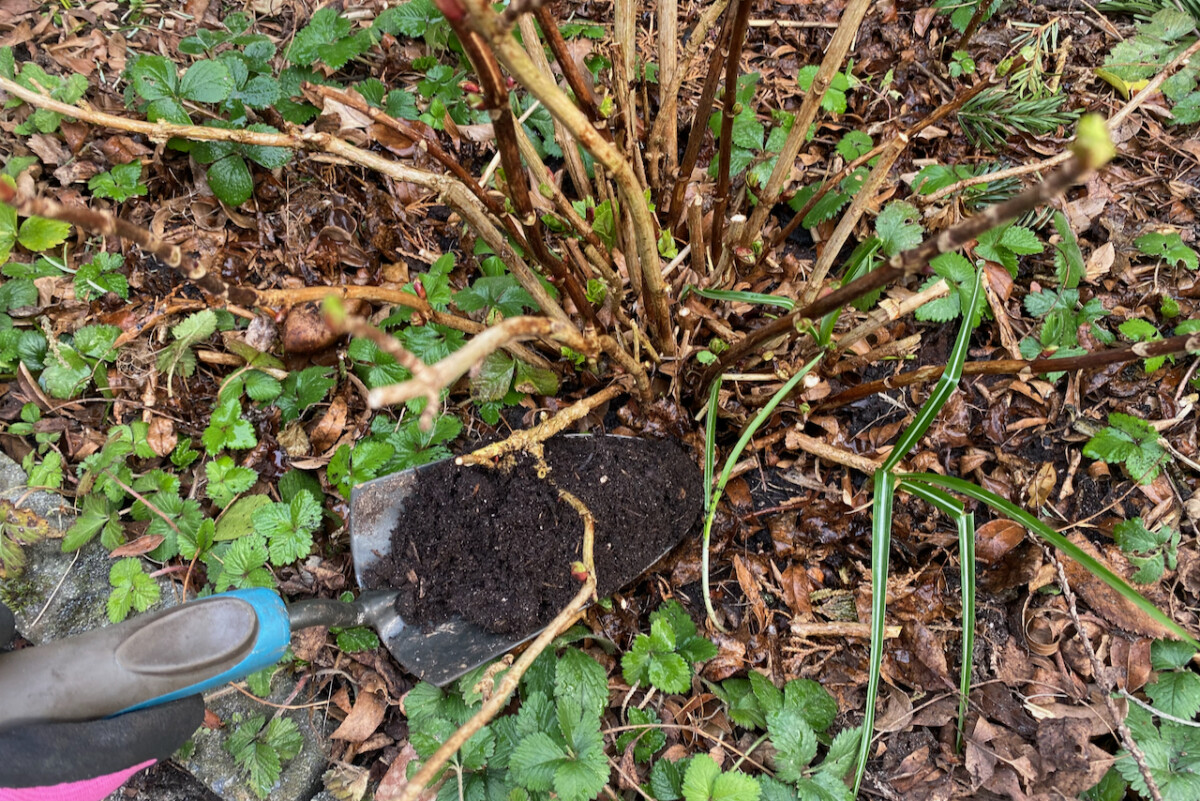
Adding compost is in lieu of fertilizing, because fertilizing hydrangeas is a bit tricky if you’re also coupling this with attempting to change their color. According to horticulturists at Oregon State University Extension, most hydrangeas will bloom a little bit better if they’re starved. And keeping in mind that the phosphate in fertilizer limits the plant’s ability to absorb aluminum, and therefore to turn blue, make sure you don’t sabotage your own flower manipulation efforts by coupling them with the wrong fertilizer regimen.
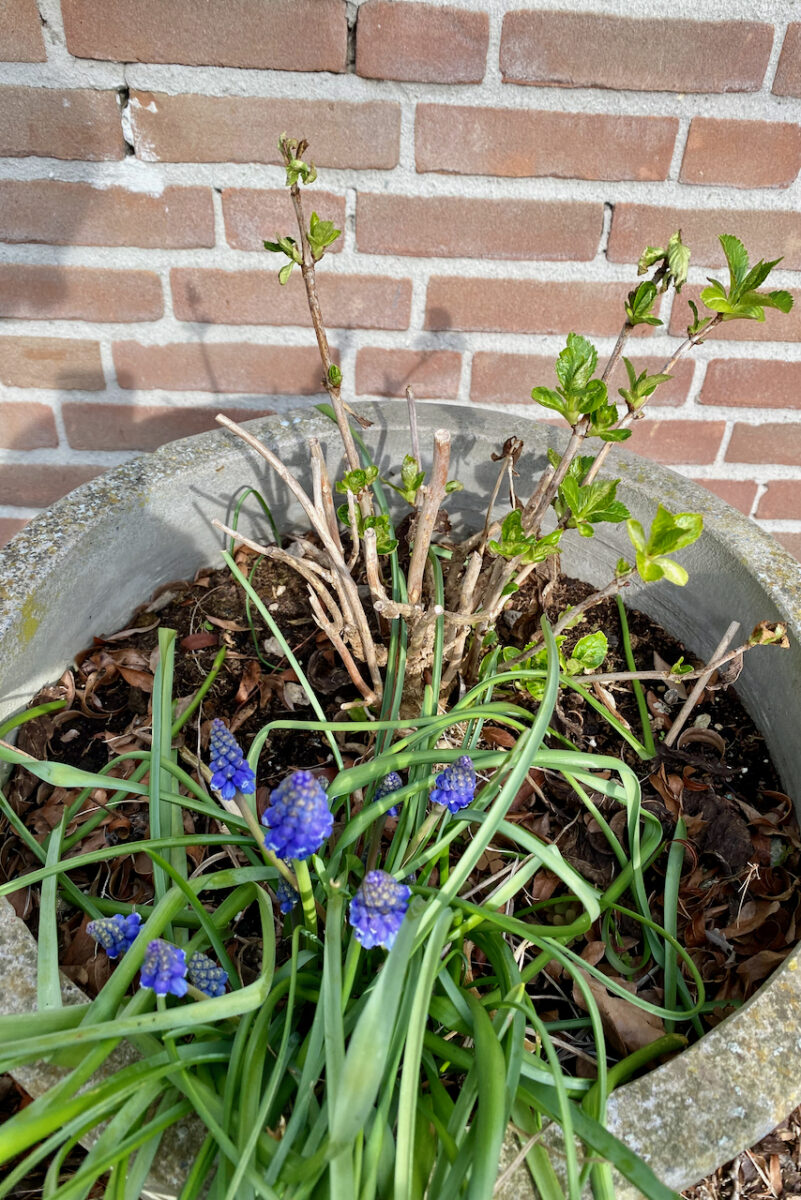
If changing the color of your hydrangea is not on your to-do list, you can fertilize your shrubs once in spring using a slow-release organic fertilizer. The slow-release part usually translates to about three months, so there’s no need to keep reapplying it. As usual, my advice is to always check the instructions on the fertilizer package and remember that “less is more” when it comes to feeding.
5. Mulch, mulch, mulch!
I like to think of mulching as the secret weapon to gardening success. It has a function in every season. In the fall, it protects the roots from soil compaction. During winter, it moderates fluctuations in temperature. And during spring and summer, its main purpose is to retain moisture underground and suppress weeds without stripping nitrogen.
If you choose to add compost or fertilize your hydrangeas in spring, mulching should come after that.
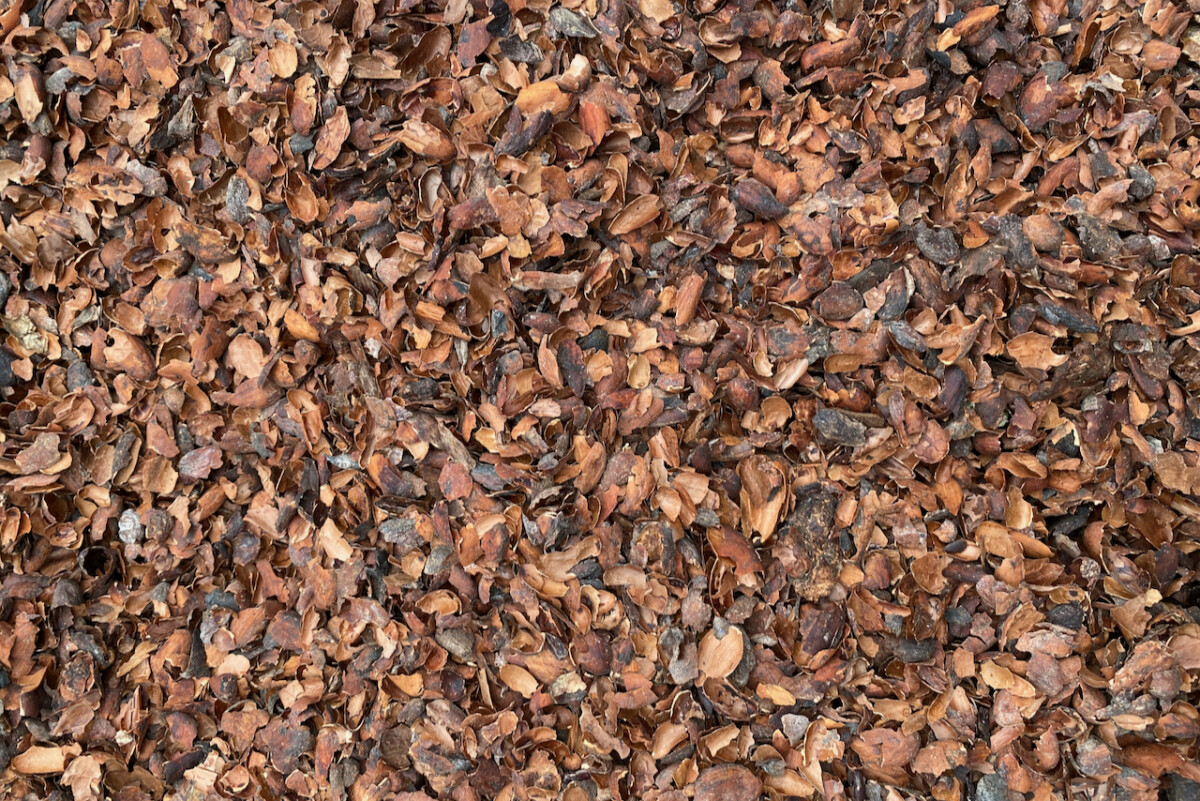
There are various mulches available on the market, such as tree bark, pine needles, crushed pine cones and cocoa bean hulls (a byproduct of making cocoa powder and other chocolate products.) Fair warning if you use cocoa bean shells though, your yard will smell amazingly sweet and you might find yourself craving chocolate every time you walk past your hydrangeas for at least a few weeks after mulch application.
6. Bring a new hydrangea into the garden.
Spring is the perfect time to dip your toe into hydrangea gardening if you’re not already growing one. Or to expand your collection with new types of hydrangea shrubs if you’re already a hydrangea connoisseur. Everything I’ve mentioned above about the timing of spring budding holds true when it comes to planting too.
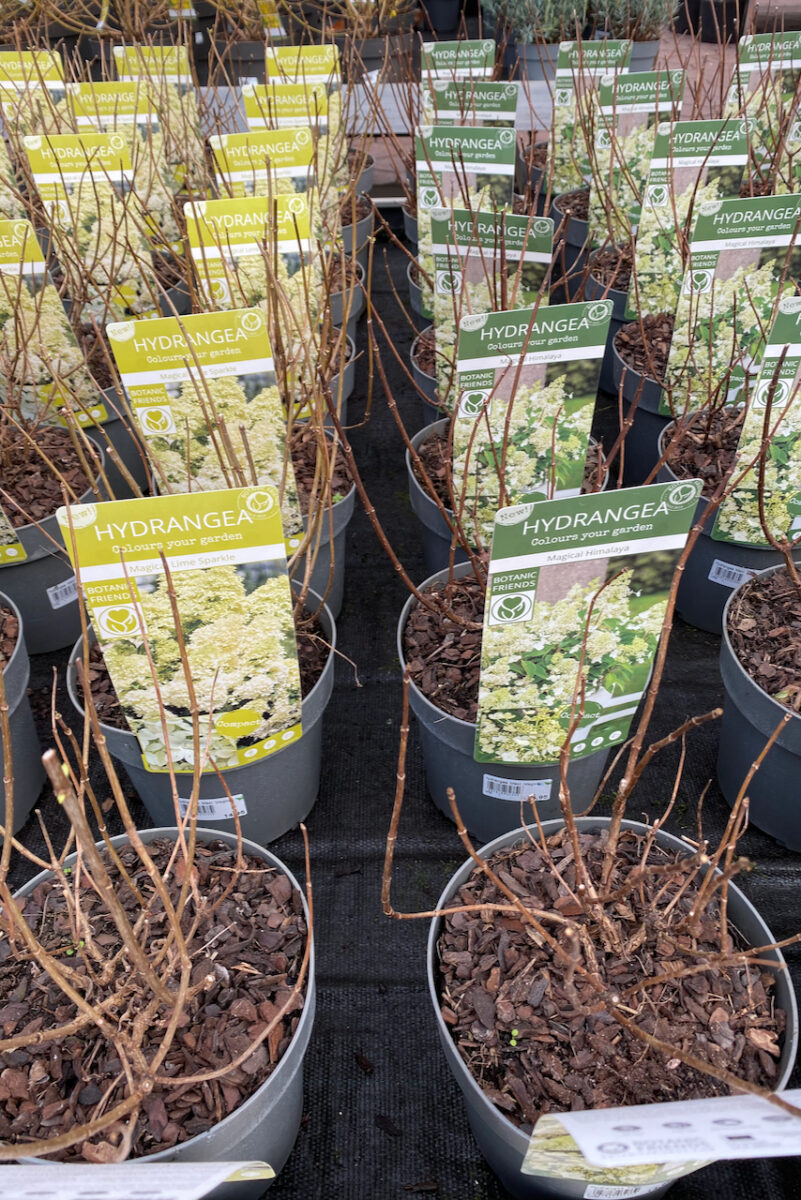
In spring, you can plant hydrangeas that bloom on old wood, as well as new wood. Obviously, you’ll be buying a pruned down shrub, but it’s easy to tell which is which just by looking at the bud formation.
Hydrangeas that flower on last year’s growth will already have buds swelling up on the stems.
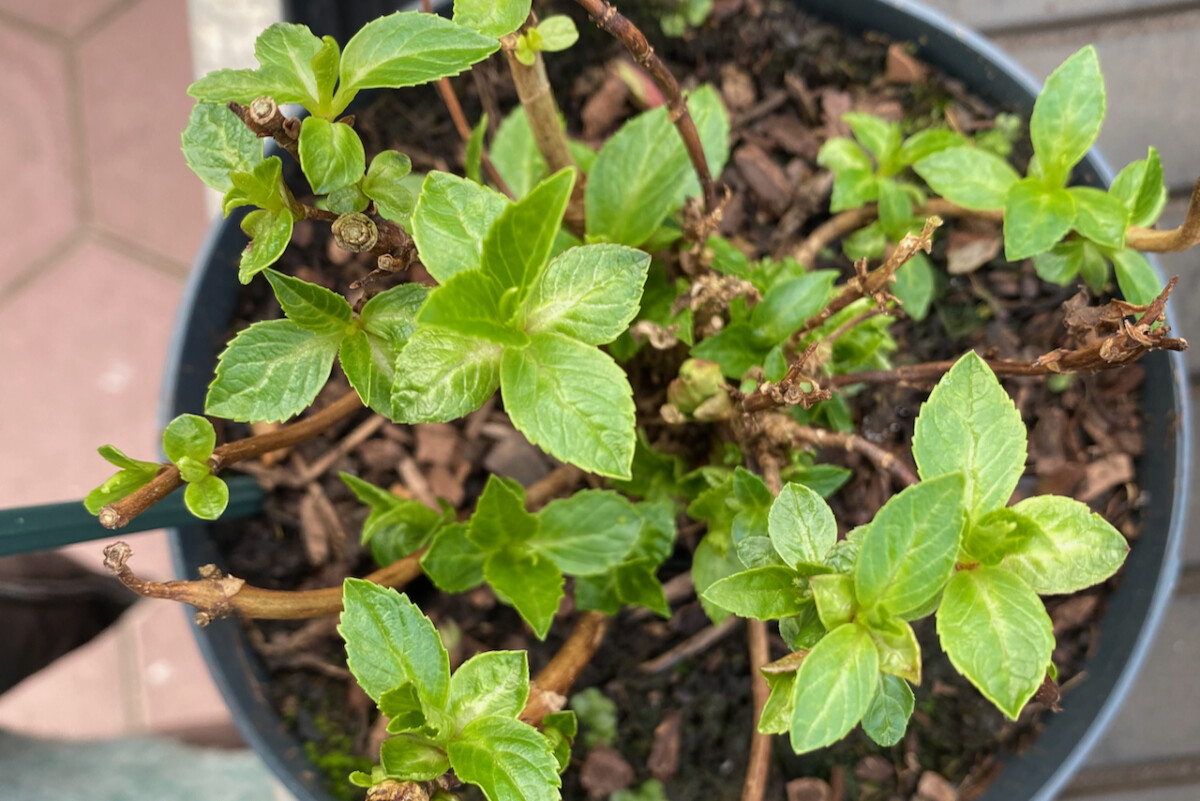
If you’re choosing shrubs that flower on new wood (the growth that is to follow this year), you can’t expect any buds. So what you’ll be buying will mostly look like a bunch of twigs. They’ve been kept pruned back by the grower or the vendor. But once you plant your new purchase, it will start growing right away.
Always double-check the size of the mature plant.
Most gardeners are good at checking the light requirements of a new plant before choosing a final location for it in our yards. Luckily, there are hydrangeas suitable for full sun as well as part-shade.
But one important factor that we often tend to disregard in the excitement of buying new plants (and I’m very much guilty of this one myself) is the size of the mature shrub. You’ll find this information on the plant label. So keep this in mind when you choose what variety you bring home. Because just looking at the bundle of sticks on the shelf will not give you any indication of how tall or wide the mature shrub will grow.
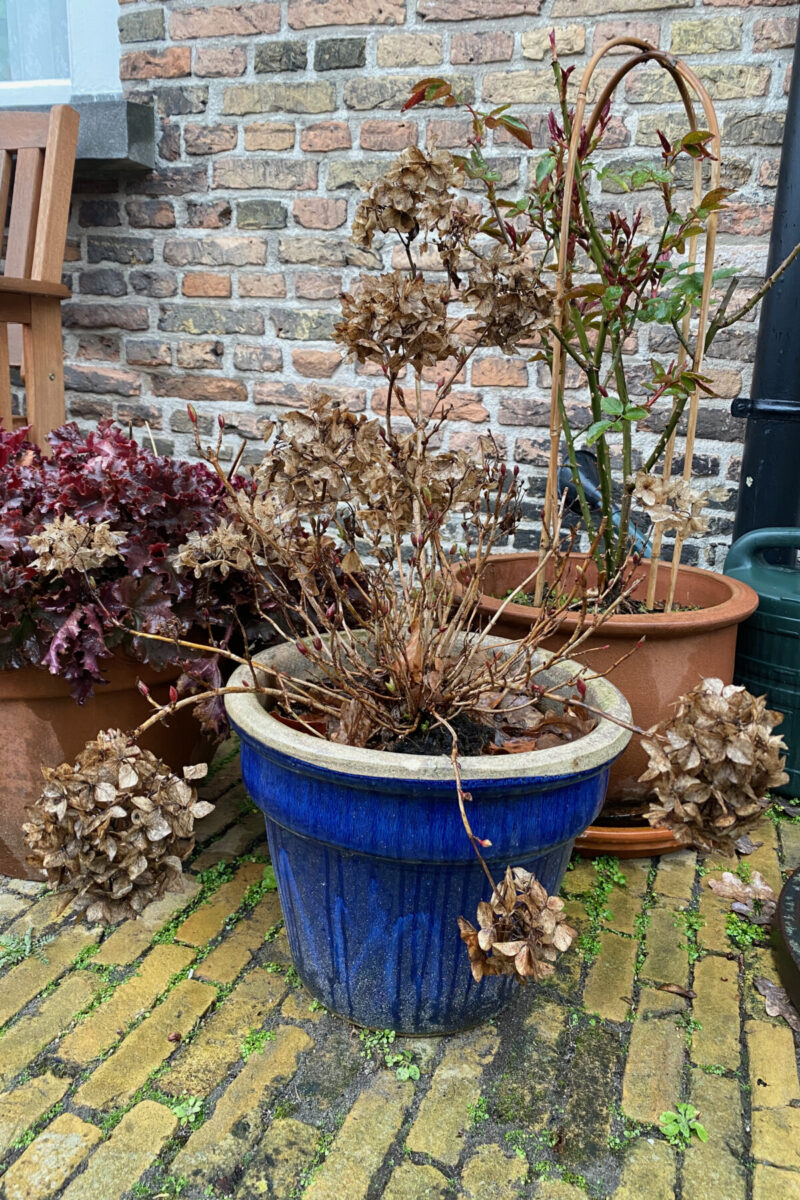
If your yard or property is big enough to accommodate large shrubs, go ahead and buy them. But if you don’t have enough space, it’s better to buy a more compact type of hydrangea. This is not the type of shrub that you can just squeeze in and keep small. I mean, you could keep most of them small, but you’d only be getting foliage. Do you really want to forfeit the large showy flowerheads that are the main attraction of hydrangeas? No, I didn’t think so!
The good news is that if you don’t have a yard at all, you can even find hydrangeas that are suitable for pots. Hydrangea macrophylla, in particular, has a lot of cultivars that have been bred to stay compact and flower profusely.
One hydrangea job I avoid in the spring.
Having already mentioned that spring is a great time to plant a new hydrangea in your garden, this next piece of advice might come as a surprise. If possible, wait until your hydrangea becomes dormant in the fall before you transplant it to a different location.
Relocating your hydrangea in the spring won’t kill it, but it might interfere with flower production this summer. This is especially true if we’re talking about hydrangeas that bloom on old wood.
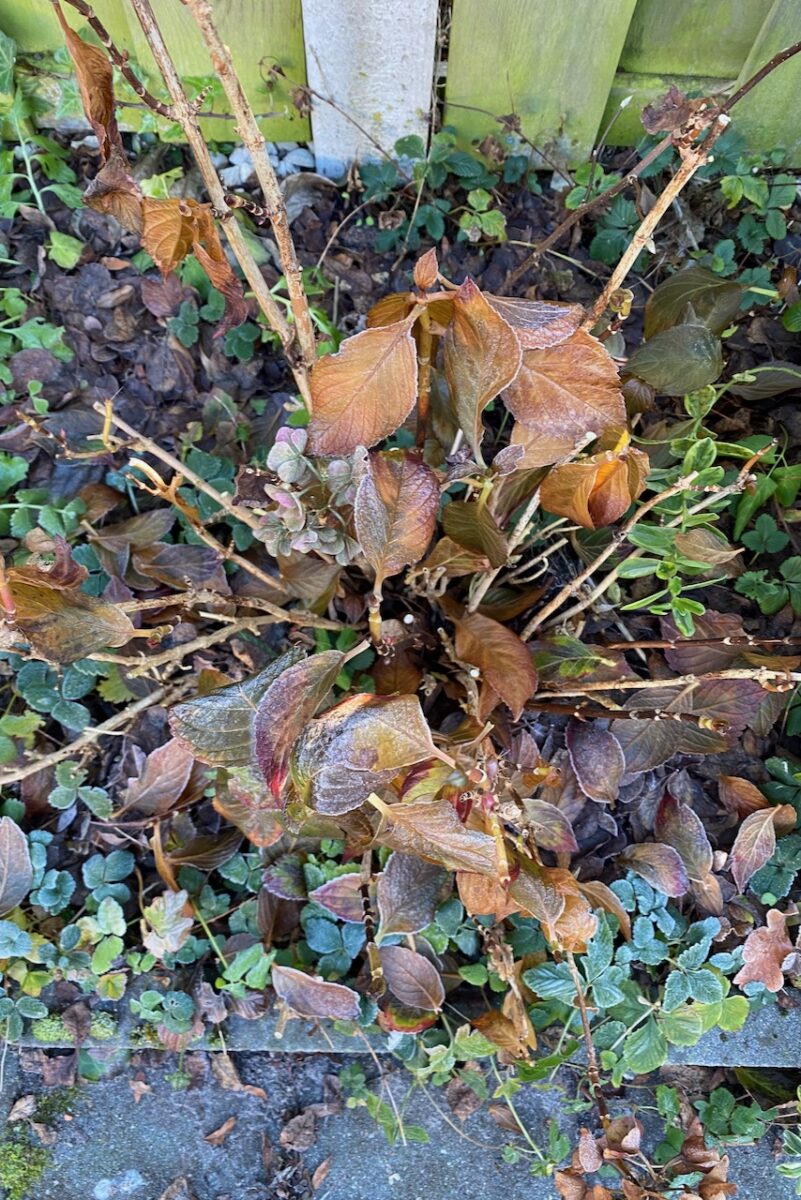
But if you’re moving your hydrangea for the sake of offering it better flowering conditions in the future, it’s up to you to decide if you can do without the flowers this year. For example, if you’re moving a poorly-performing hydrangea in order to get it into a spot with better sun, go ahead and move it. But take any bloom this year as a bonus rather than a done deal.
It’s all a balancing act between how much you’re willing to delay instant gratification for the sake of future rewards. But this aspect is true of all gardening, and it’s one of the reasons why I love spending my time tending my garden. The gratification is so much sweeter after months of delay.

